Description: Hidden part of Pivnichnoy America, zone of coniferous and coniferous-broad-leaved forests. The best development is available in the prairie part of the area. Growth along the low banks of rivers, in swamps, often on damp soils. The best development is attained on watery loams. I work like a pure plantation, and in sumishi with other woody species (clear black, black yalin, balsamic yalytsya, red maple and others.).
Thuia occidentalis "Bumbocks Tower"
Photograph by Andriy Ganov
Monoecious tree 12-20 m zavviski, more common chagar. The crown is compact, vuzkopyramidal in youth, and ovoid in mature veins, which often sinks to the ground. The bark of young roslins is smooth, red-borax, later gray-brown, which is reinforced by later lines. The needles are luscious, lustrous-green, brown-green, fuzzy (0.2-0.4 cm), sharply pressed to the leak, functioning 3 rocks and falling off at once from fuzzy needles (branch fall). Drіbnі cones (0.8-1 cm), from 3-5 pairs of thin luska, ripen in autumn on the river of flowers.
In Europe, from the middle of the 16th century, it grew everywhere, but it was growing. Russia has a view of the latitude of Arkhangelsk to the Black Sea. In Europe, the zokrema and in Russia, it is cultivated more broadly, lower be-yak-yaké іnozemne coniferous tree. At the Botanical Garden BIN from 1793. Various forms of this species are also cultivated in the LTA, in the Heartland and in my green plantings. One of the best specimens is presented in the park of the Forestry Engineering Academy (planted by E. L. Volf in 1890) and on the large garden of Grand Duke Boris Volodymyrovich near Pushkin.
In GBS since 1938, 7 zrazkіv (168 approx.) have been grown from nasіnnya and gardeners, taken from the arboretum of the TSKhA, Lipetsk LSOS, the Moscow region, and є growth of the reproduction of GBS. Tree, height 12.5 m, crown diameter 260 cm. Vegetation 5.V±12. The width increment is 6 cm. 10 years, now ripening at Zhovtni. It is easy to multiply with green live bait. Winter hardiness is povna. Living capacity is 50%. 97% of winter livestock are rooted without processing.
 "Filifera" Photograph by Evgeniya Maksimenko |
 "Golden Tuffet" Photograph by Popova Anetti |
 "Little Dorrit" Photograph by Popova Anetti |
 "Mr. Bowling Ball" (Thuja occidentalis "Bozam") Photograph by Popova Anetti |
 "Speath" Svitlin EDSR. |
 Thuja occidentals "Spiralis minima" Photograph by Mikhail Polotnov |
 Thuja occidentals "Spiralis Zmatlik" Photograph by Mikhail Polotnov |
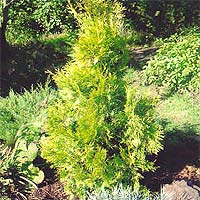 "Yellow Ribbon" Photograph by Popova Anetti |
 "Yellow Ribbon" Photograph by Oleg Vasiliev |
Zimostіyka, fagons zderev'yazuyut povnistyu. Tinevitrivala, but in culture it develops more quickly and more durably with good lighting. Growth is good. To soil fertility, it is not very strong, it does not care for water-loving, it is bad to endure dryness. Stay until dim and gas.
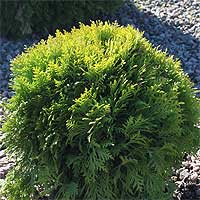 Thuia occidentalis "Miriam"
Thuia occidentalis "Miriam"
Photograph by Andriy Ganov
Already polymorphic. There are over 120 decorative forms, which are inspired by the nature of the growth, the shape of the border, the shape of the needles and the needles.
LOOKING AT GARDEN FORMS
BUT. The growth is normal straight, not dwarfed; the needles are green, the vzimku is brown:
columnar forms - "Solumna", "Fastigiata" (-Stricta), "Malonyana";
hanging forms - "Pendula" (gills of zvichaynі), "Filiformis" (gіlki filkopodіbnі);
loose-knitted - "Vodmerii", "Douglasii", "Ruramidalis", "Spiralis".
special forms (often narrow or wide-eyed) - "Gracilis", "Hetz wintergreen", "Indometable", "Smaragd".
B. Dwarf forms from splendid green luso-like needles:
round and egg-shaped - "Danica", "Dumosa", "Globosa", "Netz") - "Tiny Tom", "Umbraculifera", "Woodwardii";
pin-like forms - "Holmstrup", "Rosenhalii";
Art. Rows of the form of sizable lusco-like needles:
Zhovti forms - "Cloth of Gold", "Eurore gold", "Golden globe", "Holmstrup", "Yellow", "Lutea", "Lutea nana", "Semperaurea", "Sunkist", "Vervaeneana", "Wareana lutescens".
string-bіla form - "Meinekes zwerg".
R. Transitional forms with light and thin leaves: "Ellwan geriana", "Ellw. aurea", "Rheinogold".
D. Form only with the main leaves: "Ericoides", "Ohlendofffii" (with the most prominent pagons).
"Albospіkata", Bіlokonchikova ("Albospicata", "Alba"). A tree with a wide-pyramidal crown, 2-5 m crowns. The flow of roses. On the young roslins of the kіntsі hіlochоk іz yaskravymi bіlimi plyamami. Luskata needles, white-strokata. Light infestation of needles is especially effective in the period of growth of young pine trees. From the middle of the summer, the bіle zabarvlennya becomes especially intense and roslina swells with a stringy-brillant color. Zimost_yka. Reproduce live. Vinikla in distribution at Maxwell's in Geneva in 1875.
GBS from 1957 p. 2 marks (5 notes) taken from the Lipetsk LSOS, Poland. Tree, in 20 years, height 5.8 m, crown diameter 180 cm. Vegetation s 8.V±10. Width increment 7 cm. Do not cut. Winter hardiness is povna. 65% of winter live bait without processing, 79% of summer live bait are rooted.
"Aurea"("Aurea", "Aurescens", "Aurea Spicata"). A tree of small or medium roses, various bush-like forms, with a wide-ended crown and golden-yellow needles. View from 1857 At the Botanical Garden BIN until 1960. Ninі, from 1985, growing of the growth from the Head Botanical Garden (Moscow). In 22, the roki reached 3 m in height with a crown diameter of 1.7 x 1.7 m, winter hardiness (for other cultivars with yellow needles). In GBS since 1937, 7 signs (27 notes) were withdrawn from the Lipetsk LSOS, Ostankinsky distribution plant, and the growth of reproduction of GBS. Chagarnik, height 7.0 m in 30 rocks, bush diameter 230 cm. Vegetation 11.V±10. Width growth 4.5-6 cm. Do not fall with a saw. Winter hardiness is povna. 97% of winter livestock are rooted without processing. On the rank of the form of choice, there are a number of forms from the golden-yellow zabarvlennyam needles, which are clearly distinguished by the form of growth and other signs, like: "Aurea Nana"("Aurea Nana") - a dwarf form, with a rounded or ovoid crown, no more than 60 cm of curls, densely drooping. The needles are yellow-green in color, the needles are light green, and the needles are brown-yellow. Here are the forms: "Aurea Denza"("Aurea Densa"), "Aurea Compacta"("Aurea Compacta"), "Aurea Globoza"("Aurea Gtobosa"), "Miїїma Aurea"("Minima Aurea"), private - "Semperaurea"("Semperaurea"). |
"Bodmeri"("Bodmeri"). The crown of the fluff, ovoid shape. The height of the roslin is up to 2.5 m. Tails are short, tovst, chimeras. On the old roslins, a lot of dead woods are often collected. The needles are densely covered with pagons, mayzhe pressed down, dark green. Ymovirno, vinicla in Switzerland in 1891 roci. Recommended for group plantings.
At St. Petersburg in the Catalogs of E. L. Regel and J. K. Kesselring from 1903. At the Botanical Garden BIN z 1994, de wintery, growth is normal. Also in the LTA Arboretum collection
"Gods" ("Boothii"). Tree up to 4 m. The crown is thick, final or troch is wrong. The heads are lifted up in a victorious manner. Pagons are equally strong, densely stashed. The needles are luscious, large, light green, pale in winter. Zimost_yka. Propagated by summer (55%) and winter live bait (100%). Named in honor of James Bot, the keeper of the broth at Gamburzee. Seen by botanist R. Smith in 1874. Recommended for single, group plantings and livestock.
GBS from 1951 p. 3 samples (23 approx.) grown from live bait, taken from the Lipetsk LSOS. Tree, 39 years height 5.2 m, crown diameter 250 cm. Vegetation 13.V±8. Width increment 3.5 cm. Do not fall with a saw. Winter resistance of the temple. 100% of winter livestock are rooted, processed with 0.01% IMK for 24 years.
"Beaufort" ("Beaufort"). In height, that growth is close to the normal type of growth. Young pagons and needles are rippled. May be more zabarvlennya, lower at cv. Variegctta. Originally taken in Holland, dated 1963. At the Botanical Garden BIN z 1995
"Brabant"("Brabant"). A tree with a height of 15 - 21) m. Crown diameter 3-4 m. The crown is finite. The bark of the chervona is grayish-brown, which can be seen. The needles are luscious, green, taking the bribe. The flowers of the flower are herbaceous, the cones are brown, dovgasto-ovoid, 0.8 - 1.2 cm long. River growth at a height of 30 cm, hem 10 cm. Tinevitrivala. To the soil it is not viable, to endure like dryness, so it is superficially fertile to the soil, but let it be fresh, to bring it to the fertile loams. Frost resistance. Good to bear the haircut. Zastosuvannya: single landings, groups, living flesh.
"Wagner" ("Wagneri"). Tree of small growth, 3.5 m curls. The crown is narrow, dense, narrowly conical, straight uphill, thinned. Pagons are thin, viskhіdnі or troch drooped. The needles are thin, green or grayish-green. Better growth in open spaces and open spaces. Zimost_yka. Rooted by summer (65%) and winter (100%) live bait. Vinikla at 1890 roci at the breeder Karl Wagner in Leipzig with the famous "Vareana". It is recommended for planting alone and in groups of living houses. Bazhano vikoristovuvati when mixing livestock.
Dendrosad LTA has a sprat of young trees, which do not freeze and are well-disposed.
At GBS s 1952 1 szrazok (13 approx.) Withdrawals from the Lipetsk LSOS. A rich-stemmed tree, in 38 years, height 4.9 m, crown diameter 240 cm. Vegetation s 8.V ± 10. Wider growth 1.5-6 cm. Do not saw. Winter hardiness is povna.
 Thuja occidentalis "Wareana" Thuja occidentalis "Wareana"
Svitlin EDSR. "Vareana" ("Wareana"). A small tree or chagarnik with a narrow cone-shaped or pyramidal crown, height - 5 - 7 m. Heads of tovst, short, to stand upright. Clear bright green, without a brown tint. Propagated by summer live bait (88%), woodgrass (75 - 100%). Appeared in the culture of the other half of the 19th century in Europe. Good breeds with live bait (60%). It is recommended for single and group plantings, for livestock bіlya budinkov. Highly valued in decorative gardening. The form is not even uniform, but impermanent, to that which often grows out of the present. A valuable winter-hardy form, in the collection of the Forestry Engineering Academy. At GBS s 1957 2 zrazka (3 approx.) Withdrawals from the Lipetsk LSOS. Tree, in 20 years, height 5.2 m, crown diameter 190 cm. Vegetation s 8.V±10. Wider growth 3-5 cm. Do not saw. Winter hardiness is below the middle. |
"Vareana Lutescens", Vareana Zhovtiyucha("Wareana Lutescens"). It is similar to the habitus with the Wareana form, but lower, it can reach (deposited from minds) 1.5-2.5 m in height in 10-15 years. In the third century, the crown becomes broad. The needles of a light yellow-green color of the wind, are more infested in the first half of the growing season, nabuvaet bronze vіdtinka vzimku. The challenge is unusual for the tuy, and this cultivar can be vicorated for the creation of barvy compositions in other forms, the creation of different colorful varieties. Zimost_yka. Propagated by summer and winter live bait (98 - 100%). Appeared in the rozplidnik G. Gosse in 1891 (Nimechchina). Recommended for single and group plantings in gardens and alpine gardens.
Near St. Petersburg on the roses of E. L. Regel and J. K. Kesselring from 1904. At the Botanical Garden BIN sees the house from 1913. In the present hour (since 1995), young stars are swirling, which in 12 years reached 1.5-1.7 m h.
"Vervena" ("Vervaeneana"). duje garne form. A tree up to 15 m with a crown, with a string of a vuzkokonіchnoy crown. Leaks are thin. Numerical ridges, lower and softer, thicker. The needles are light-yellow or light-green, bronze-brown. Zimost_yka. Propagated by summer (82%) and winter (100%) live bait. Vinikla in 18b2 rock in the Vervain garden in Ledebersee (Belgium). It is recommended for planting with tapeworms, groups, alleys of white buds.
Good-looking copies are in the collection of the Forestry Engineering Academy.
At GBS z 1952 2 zrazka (14 approx.) reproductions of GBS. Tree, 38 years, height 8.8 m, crown diameter 230 cm. Vegetation s 8.V110. Wider growth 3-7.5 cm. Do not fall with a saw. Winter resistance of the temple.
"Woodward"("Woodwardii"). Dwarf form. The krone of the kulyast, to old age is more widely rounded. Height -1.5 - 2.5 m, width - up to 5 m. Pagons and needles are straight, flat. The needles of the vlіtku and vzimku are dark green, from both sides the same barvlennya. There is no place to go, the hour of introducing culture is until 1923. Zimostіyka, but in Suvori winters freeze up kіntsі odnochіchnyh pagonіv. Reproduce live bait (75 - 100%). Recommended for group plantings on rocky plots and lawns.
At GBS s 1952 1 zrazok (6 approx.) withdrawals from the Netherlands. Chagarnik, height 1.6 m in 17 rocks, crown diameter 100 cm. Vegetation 8.V±9. Wider growth 1-3.5 cm. Do not cut. Winter hardiness is below the middle.
"Getz Midet"("Hetz Midget"). Rounded, rather large dwarf form; to finish the pagon; river growth to become close to 2.5 cm. The needles are green. Have 1925 r. selected as a radiance from Fairy-spreader; imported 1942 r.
"Goetz Wintergreen"("Netz wintergreen"). The shape of Keglepodіbna, which is narrower in growth. The needles of that vzimka are overgrown with green and beautiful. Hetz, USA, before 1950
 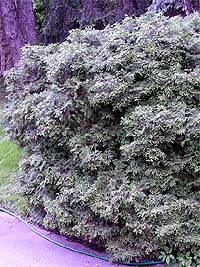 Thuja occidentalis "Globosa" Thuja occidentalis "Globosa"
Photograph by Zliv Kostyantin Aleksandrov Photo right-handed EDSR. "Globoza", Sharopodibna ("Globosa"). Dwarf form 1.2 m zavishki and close to 1 m zavishki. The shape of the crown is rounded. The pagons are straight and flat, rising uphill, densely ruffled, which intersect, evenly grow down. The needles are lusco-like, light green hinged, green inlet and gray-green or brown in winter, with gleaming ridges. Zimost_yka. Reproduce live. Vіdoma u kul'turі z 1874 roku. Suitable for single and group plantings in rock gardens, containers for landscaping and gardening. Near St. Petersburg on the roses of E. L. Regel and K. Ya. Kesselring from 1878, in BIN from 1891. Roslini tsієї forms in tuєvіy alei Botanіchnogo garden BІN, vysadzhenі 9 May 1945 r. So is the collection of the Lisotechnical Academy. In rich other gardens, roslins that grow under the name of the name do not exceed 1.25 m vis. In the given hour, for decorative, compact, and large crowns, other cultivars were turned over. GBS from 1950 p. 2 spices (6 approx.) taken with live bait from Lviv, є reproduction of GBS. Chagarnik, height 1.3 m in 20 years, crown diameter 100 cm. Vegetation 8.V±10. Shhorіchny growth up to 5 cm. Do not cut. Winter resistance of the temple. 100% of winter livestock are rooted, processed with 0.01% IMK for 24 years. |
"Globoza Nana", Ball-shaped Low ("Globosa Nana" Dwarf Chagarnik up to 0.3 m. Guessing by looking small green bushes. The crown is compact, kulasta. The needles are friable, luskopodibna, dark green with a gleaming gale. More than other forms tolerate dryness again, require more shade and more frequent watering. in the foreground are mixed groups.
"Goveya" ("Hoveyi"). Dwarf form 1 - 1.5 m zavishki. The crown is ovoid-rounded. The pagons are strictly straight, thin, red, ruffled in a perpendicular plane, which creates an excellent similarity with a similar biota. The needles are light green, non-blissful, brown in winter, on both sides with salices. Zimost_yka. Propagated by summer (75%) and winter (100%) live bait. Vіdoma u kulturі z 1868 roku. Recommended for single and group plantings on rocky plots, for growing near containers.
GBS s 1957 1 approx. taken away by gardeners from Poland. At 22 rocks, the height is 5.3 m, the diameter of the crown is 170 cm. Do not powder. Winter hardiness is average.
"Gracilis" (Gracilis). Form shvidkozrostayucha, fluff; females are long and thin, garno diverge on all sides; the frogs are thin, it is strong to stand. Luski dovgastі, thin, light green. KHN 204. 1875 Old English variety.
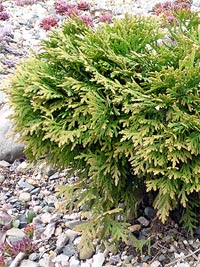 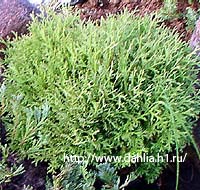 Thuja occidentalis "Danica" Thuja occidentalis "Danica"
Photograph of Zliva EDSR Svіtlina pravoruch Golubitskaya Lyubovі Fedorivna "Danika"("Danica"). Dwarf form. The variety was bred in Denmark in 1948. Height 0.6 m, crown diameter 1 m. The bark of the chervona is grayish-brown, which can be seen. The needles are luscat, dense, green, soft, bliskuch, vzimku - brown-green. Growth is povіlno-Tіnevitrivala. To the soil it is not viable, to endure the dryness of the soil and the transcendental volatility, but let it be fresh, to add volatility to the fertile loams. Frost resistance. Zastosuvannya: single plantings, groups, rocky rocks. At the Botanical Garden BIN from 1992. (from Prague, Czech Republic). |
"Dutlas Pyramidalis", Douglas Pyramidalna("Douglasii Pyramidalis"). per old-fashioned look guess cypress. The shape of the crown is vuzka, columnar, height - 10 - 15 m. The pagons are thin, arc short, straight. Green twigs, what to wash. similar to fern leaves. The needles of marsh-green color are flat. On the lower ridges, it hangs early and often falls off. Shown on the ear of the XX century in the Arnold Arboretum (USA) and taken by Shpet in Berlin (Nimechchina). Zimost_yka. Dzhe tіnyovitrivala. Propagated by summer (68%) and winter (100%) live bait. It is recommended to hang out in groups, or alone in the house. Added won and for livestock. Close to Thuja occidentalis "Spiralis", can't beat it.
Viewed from 1891 Unforgettably, the letter appeared in St. Petersburg: at the Botanical Garden of BIN (1912) and on the roses of E. L. Regel and K. Ya. Kesselring (1914).
At GBS s 1950 1 srazok (8 approx.) rotations from nasinny, taken from Lipetsk LSOS. Tree, in 39 years, height 9.0 m, crown diameter 240 cm. Winter hardiness is povna.
"Dumosa"("Dumosa"). Dwarf form, height and crown diameter 1 m, flattened or slightly rounded crown, irregular. Flattened like a form "Recurva Nana" (often stray with it), but the pagons are not so evenly bent and often similarly flat, on the tops there are richly vertically flattened thin pagons about 10-15 cm of a weed, and there are few flattened pagons, like in a typical tuї zahіdnoї, yakі also not flat, but bent, scarlet short, more splayed. Often vikoristovuyut in alipinaria.
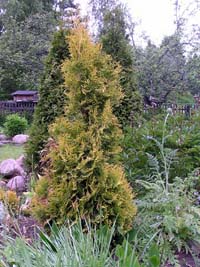 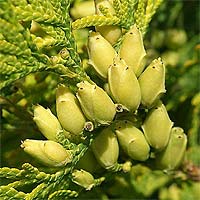 "Europe Gold" ("Europe Gold"). The variety was bred in Holland in 1974. Let's guess "Smaragd", but it's more like it's taller. Chagarnik. Height 4 m. Crown diameter 1 - 1.2 m. The bark of the chervona is grayish-brown, which can be seen. The needles are luscious, dense, vzimku - golden-yellow, with orange blossoming. Natural growth "at a height of 10 cm, a crown of 5 cm. Tinevitrivala grows more than enough. It is not viable to the ground, it can tolerate dryness to the soil and is superficially fertile, but if it is dry, it should be dry, it should be planted with fertile loams. It is good to tolerate a haircut. Near St. Petersburg (BIN) since 1994, a full winter, in 13 years reaching the height of a human height (160-180 cm). The photo on the right is Korzhavin Kostyantyn
|
"Indomitable"("Indomitable"). Mutation "Elegantissima", which grows rapidly; the needles rise. The needles are dark green, ale vzimku reddish-brown. Close 1960, L. Conein, Reyuvik, Holland. Especially wintery.
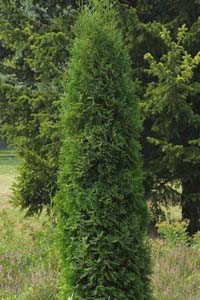 Thuja occidentalis "Columna" Thuja occidentalis "Columna"
"Garden collection" Photo right Pavlova Natalia "Columna" ("Columna"). Upright coniferous with a narrow columnar crown, short needles, which are narrow and horizontal. Growth is good. Height up to 10m. The root growth is about 15 cm. The crown diameter is up to 1.5 m, the crown growth is about 5 cm. The bark is red-brown, short. The needles are luso-like, thick, dark green, gleaming, do not change the charge. The root is thin, thick, with mycorrhiza. To ґruntіv nevibaglyva, growth yak on sour, so i on puddle watery and fertile substrates. Sensitive to the strengthening of the surface of the soil. Roztashuvannya: sleepy or pivtin Tsіlkom zimostіyka. Zastosuvannya: okremi copies or groups, appendages for livestock. At the Botanical Garden BIN from 1936 also grow at the Lysotechnical Academy. |
"Compact", Shchilna ("Compacta""). Dwarf form, otrimana in the form of "Pyramidal Shchilnoy". Not a large tree or a chagarnik, up to 2 m of a cusp and 1 m wide. The needles are bluish-green, full growth, winter hardiness, rooting by summer livestock 75%, winter livestock - 100%, described by Pearson from the USA around 1850. Recommended for single, group plantings, for livestock.
GBS from 1938 p. 1 piece (3 copies) was taken by 5 rows of gardeners from Kiev. Chagarnik, height 10 m in 56 rocks, crown diameter 290 cm. Vegetation 13.V±8. Width increment 5 cm. Do not cut. Winter hardiness is povna.
"Kristata", Grebinchasta ("Cristata"). Slim thinned tree 3 - 5 m curls. The crown is rounded, the splashing of the Gilka is short, straightened comb-like uphill. The needles are gray-green. Zimost_yka. Propagated by summer (93%) and winter (100%) live bait. In culture vіdoma since 1867. It is recommended for single and group plantings, for livestock breeding.
GBS from 1952 p. 3 sprouts (9 approx.) grown from live bait, taken from Lipetsk LSOS, є growth of GBS reproduction. Tree, in 20 years, height 4.0 m, crown diameter 170 cm. Vegetation s 8.V±10. Width increment 7 cm. Do not cut. Winter hardiness is povna.
At St. Petersburg in the Catalogs of E. L. Regel and J. K. Kesselring from 1904. At the Botanical Garden BIN z 1990, wintering.
"Lutea", Zhovta ("Lutea"). Tree up to 10 m crown Crown fluff, vuzkokonіchna or pіramіdalna. The needles are fuzzy, splashing, glimmering to the beast, golden yellow, below - light yellow-green. Even better on dark green aphids. The charge of the zabarvlennya does not change, but the troch is dark. Zimost_yka. Shvidko growth. Zavyazuє masu nasinnya, ale with to the most recent reproduction less than 25% are maternal signs of decline. That is why it is propagated by summer (75%) and winter (88 - 100%) live bait. Come from the USA, at the culture of the house until 1873. It grows often, it is left with one of the best yellow-farmed forms. Recommended for single and group plantings in gardens, white houses. See so that " Zhovto-strokat"(f. lutescens) - from a densely branched, pyramidal crown, from yellow-lined needles. Zimost_yka. At the Botanical Garden BIN from 1886, Mayzha at the same time appeared on the roses of E. L. Regel and J. K. Kesselring (1892). Possibly, a synonym for the form Aіrea. In Denmark, in the collections of BIN and LTA. GBS from 1957 p. 5 zrazkіv (9 approx.) taken from Poland, є growth of GBS reproductions. Chagarnik, in 20 years height 5.1 m, crown diameter 160 cm. Vegetation s 12.V±10. Wider growth 5-8 cm. Do not saw. Winter hardiness is povna. |
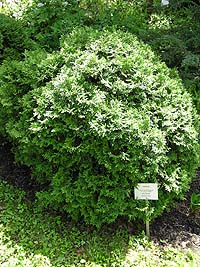 Thuja occidentalis "Little Gem" Thuja occidentalis "Little Gem"
Svitlin EDSR. "Little Jam" ("Little Gem"). Dwarf form with a crown width of up to 2 m, and the height is significantly smaller. The crown is flat-rounded, flattened. The necks are rough, straight, the necks that rise, twist. The needles are dark green, vzimku brown. The form is close to "Recurva Nana". Zimost_yka. Propagated by summer live bait (62%). It is recommended to hang out in groups, or alone on stony plots, suitable for living livestock. Viewed from 1891 At the Botanical Garden BIN z 1984 (cuttings from Salaspils, Latvia). GBS from 1973 p. 1 shot (7 notes) was taken by live bait from Lviv. Chagarnik, height 0.55 m in 17 rocks, crown diameter 70 cm. Vegetation 18.V±10. Width increment 0.5 cm. Do not cut. Winter resistance of the temple. |
"Malonyan" ("Malonyana"). Gostrovershinna and vuzkokolonopodibna form 10 - 15m zavvishe. The pagons are short, brown, densely velvety, flat, sharply ruffled. The needles are shiny, green, clear-sighted. Zimost_yka. Multiply us. When growing, 85% of syantsiv retain the main form. Rooting with summer live bait 100%. Otriman Czech (Arboretum Mlynany), until 1913 Nini is widely used in culture. It is recommended to visit alone or in groups of bіlya budinkіv. It is possible to vicorate when creating livestock. Near St. Petersburg in 1937, the first to test the Dendrosad of the Forestry Engineering Academy N. M. Andronov. At the Botanical Garden of BIN the house is from 1967. Good copies are in the Dendrosad Lisotechnical Academy. |
"Olendorffi" ("Ohlendorffii"). Chagarnik is larger than 1 m of the crown, which grows unevenly in width. Pagoni dovgі, straight, tight, only on the top of the gap. The needle-like needles on the ends of the pagons are cross-stitched, awl-shaped, about 12 mm long, reddish-brown. Luskasta needles are friable, stashed in 4 rows, on the other side it turns red-brown. Appeared in Hamburg at Ohlendorf's in 1887. Zimost_yka. Reproduce live bait (39%). It is also decorative and meritorious on a wider scale for landscaping alpine mountains, de її hanging in groups or solo on parterny lawns. You can viroshchuvat have containers. At the Botanical Garden BIN z 1986 also grow at the Lysotechnical Academy. |
"Pumila" ("Pumila") Chagarnik up to 2 m of the crown. In GBS from 1952, 1 specimen (4 copies) was taken by seedlings from the Netherlands. Tree, in 20 rocks, crown diameter 130 cm. Vegetation from 8.V ± 10. Wide growth 1.5- 2 cm.
 Thuja occidentalis "Piramidalis compacta" Thuja occidentalis "Piramidalis compacta"
Photograph by Nadiya Dmitrieva "Pyramidalis Kompakta", Piramidalna Shchilna("Pyramidalis Compacta"). Tree up to 10 m. The crown is narrowly finite. Pagons are densely bellowing, strong, sharply pressed one to one, short. The needles are large, luskopodіbna, light green, with a faint glare. Zimost_yka. In culture vіdoma since 1904, widened. Recommended for single and group plantings. At GBS s 1952 2 zrazka (10 approx.) Were taken with green bait from Lipetsk LSOS. Tree, 38 years height 9.0 m, crown diameter 150 cm. Vegetation 7.V±10. Wider growth 5-12 cm. Do not fall with a saw. Winter hardiness I. 62% of winter livestock are rooted without processing. |
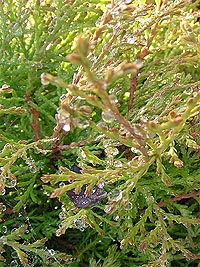  Thuja occidentalis "Rheingold" Thuja occidentalis "Rheingold"
Svitlin EDSR. "Ringold"("Rheingold"). Transitional form, the young one has a crown of a kulyasta, later - a shirsha, a height - up to 1.5 m. The leaks are thin. Youthful growth of veins can make a garnier of erysipelas. The needles are light-golden-zhovta, often holchasta, often luskopodіbna. Propagate with live bait (48%). Recommended for single and group plantings on rocky plots, as well as for growing in containers. Roslini, which are cultivated under the name Rheingold, is nothing else, like the reproduction of "ericoidni" juveniles of the Thuja occidentalis f. Ellwangeriana Aurea Roslins, multiplied by such a rank, save their golden yellow color Trival hour In older roslins, with age, more and more luscious leaves appear, apparently, turning to the outward form of Ellwangeriana Aurea. Thuja under the name Rheingold appeared in culture around 1900. near Lübeck (Nimechchina). In St. Petersburg, E. L. Volf (1917) was recognized as the first. At the Botanical Garden BIN z 1984 (taken by live bait from Latvia, m. Salaspils), frosty in cold winters. Here it is a tree, which is of sufficient growth, with a wide crown. So is the collection of the Arboretum of the Lisotechnical Academy. |
"Riversi"("Riversi"). Tree up to 5 m. The krone is compact, shirokokon_chna. Pagons are short, wyvern. The needles are yellowish, the vzimka is yellowish-green. Zimost_yka. Reproduce live bait (65 - 75%). Recommended for livestock and group plantings on stony plots, or alone on the lawn.
At GBS s 1958 1 szrazok (12 approx.) Withdrawals s Nizhny Novgorod. Tree, 30 years height 5.0 m, crown diameter 140 cm. Vegetation 12.V±8. Width growth 7-12 cm. Do not saw. Winter hardiness is average.
"Rosenthal"("Rosenthalii"). The shape is evenly columnar, up to 5 m of a cusp. Pagons are short, narrow, straight, perpendicular. Numbers are numerical, trochs are rounded. The needles are dark green, bliskucha. Growth is superbly correct. Introduced into culture in 1884 Zustrichaetsya often less in Europe. Zimost_yka. Rooting with summer live bait is 92%, with winter livestock – 100%. Recommended for single and group plantings, livestock.
Near St. Petersburg on the roses of E. L. Regel and J. K. Kesselring from 1909. At the Botanical Garden BIN from 1949, at the given hour, the eyes of young roslins are swirling.
At GBS s 1955 1 zrazok (9 approx.) withdrawals from Holland. Tree, height 2.3 m, crown diameter 120 cm. Vegetation s 8.V±10. Large growth 1.5-3 cm, grown to the full extent. Pilk s 5.V±6 to 12.V±4. Now ripening to the cob of leaf fall, hanging from the box at the chest. Winter hardiness is povna.
"Salaspils" ("Salaspils" (Th. occidentalis "Globosa Salaspils"). Dwarf, fairly growing, bushy form, which clearly glimmers, with thick kulasty crown. Reaches less than 55 cm in height in 30 years. The green color of the needles does not change the fee. It is a mutation, a species of sires from the cultivar "Globosa". Taken in Salaspils Botanical Garden, Latvia, 1928-1932 pp. At the Botanical Garden BIN z 1984 living life without interruption from Salaspils.
"Sankist"("Sunkist"). Dwarf form. Height 3 - 5 m, crown diameter 1 - 2 m. The crown is finite. The bark of the chervona is grayish-brown, which can be seen. The needles are luscat, golden-yellow, when releasing - yellow, vzimku - bronze. Growth is good. Light-loving. To the soil it is not viable, to endure the dryness of the soil and the transcendental volatility, but let it be fresh, to add volatility to the fertile loams. I bury to endure a haircut. Frost resistance. Zastosuvannya: single planting, group. V_doma as a reduction of the variant of T. occidentalis "Lutea".
"Semperaurea", Vіchnogoldote("Semperaurea"). Tree 10 - 12m curls. The crown is wide-ended. Flow of comrades. Growth is tighter. Kіntsi pagonіv i young needles densely golden, vzimku needles stormy, becoming yellow-brown. The characteristic vіdmіnіst ієї forms vvazhаєєєєєєєєє scho zhіlochki vіdmіnіst rubber for pіvden. Zimost_yka. Propagate with live bait, but rooting is not more than 30%. Vіdoma since 1893. Often heard in Western Europe. In the arboretum Kurnik (Poland) in 1932 the bula was taken away independently. One of the shortest zhovtofarbovannyh forms of tuї zahіdnoї (f. aurescens Wrobl. ex Browicz et Bugala), which is characterized by smaller sizes, and itself: height - 4 - 5 m, narrow-ended crown, young pagons and needles may be brightly golden. Zimost_yka. Reproduces live bait (72%). Recommended for group plantings bіlya budinkov. Near St. Petersburg on the roses of E. L. Regel and J. K. Kesselring from 1907. At the Botanical Garden BIN z 1995 |
  Thuja occidentalis "Smaragd" Thuja occidentalis "Smaragd"
Photograph by Oleksandri Shcherbakova, firm "Garden Collection" Photo right-handed EDSR. "Emerald"("Smaragd"). Additive form up to 2 m. The crown is cone-shaped, weakly glancing. Pagons roztashovanі near the vertical plane. The little trees stand far away, one in the same, glossy, fresh green inflow and charge. Otriman in 1950 in Denmark (Questchard). In this hour of May, the great drink from lovers of roslin. Reproduce live bait (53%). Recommended for group and single landings. You can try it when you create livestock. At the Botanical Garden BIN from 1993. also grow at the Arboretum of the Forestry Engineering Academy. |
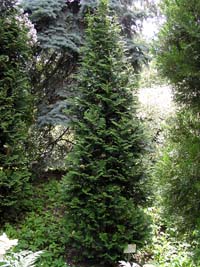 Thuja occidentalis "Spiralis" Thuja occidentalis "Spiralis"
Svitlin EDSR. "Spiralis" ("Spiralis"). A tree with a narrow conical crown, up to 15 m crowns. The pagons are twisted with a twist and turn so that they make a spiral, as if marveling at the beast. The little trees are short, they tell the leaves of some ferns. The needles are bluish-green. For the speed of growth, I will turn over all other forms of that zahadnoy. Vіdoma u kul'turі z 1920 roku. There is no place to go. Multiply us. With the current multiplication of 30% of the sijants, the signs of the form are declining. Rooting with summer live bait 95%. Zimost_yka. Recommended for single and group plantings. Effective in alleys. In culture since 1920 at the Botanical Garden BIN in 1948, also LTA. At GBS since 1957 2 signs (7 notes) were taken from Denmark, the Netherlands. Tree, height 8.6 m, crown diameter 160 cm. Vegetation 12.V±10. Wider growth 5-9 cm. Do not saw. Winter hardiness is average. |
  Thuja occidentalis "Stolwijk" Thuja occidentalis "Stolwijk"
Photograph by Zliva EDSR. photo right Ganova Andriya "Stolviyk" ("Stolwijk A new cultivar, which is not found in light dendrological plants. Taken from Holland, at the Stolwijk Nursery, born in 1986 (Erhardt, 2005). reach close to 1 m vis. The lower part of the crown is dense, the upper part is thin, sometimes rich-stemmed. |
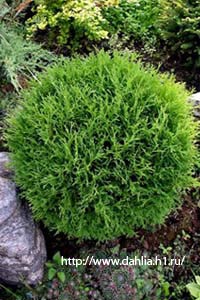 Thuja occidentalis "Tiny Tim" Thuja occidentalis "Tiny Tim"
Photograph of Golubitskaya Lyubov Fedorivna "Taєmnitsi Tim" ("Tiny Tim"). Dwarf form, bred in 1955 roci, narrower than garn. Height 0.5 -1 m, crown diameter 1 - 1.5 m. The bark of the chervona is grayish-brown, which can be seen. Luskata needles, dark green. At 10 roki, the height of the roslin cієї form is 30 cm, the diameter of the crown is 40 cm. Light-loving. Until the soil is unviable, to endure the dryness of the soil and the transcendental bliss, but let it be fresh, to bring it to the fertile loams. Frost resistance. Zastosuvannya: solitary landings, groups on stony hills. |
"Tuyopsoides" ("Thujopsoides"). According to the needles, the Japanese tuevik is guessed, of energetic growth, with a free crown and larger cones. She lived until 1894, first appeared in Duisburz (Nimechchina). Growing on the Karelian Isthmus, in the Arboretum of the scientific research station BIN "Vidradne" since 1986. (originated from Salaspilsu, Latvia).
"Umbraculifera", Parasolkopodіbna ("Umbraculifera"). Dwarf form up to 1.5 m. The crown is flat-rounded, umbrella-like to the beast. Flow straight. The ends are thin, rounded, drooping. Pine sap, dribna, dark green with a blaky vіdtinkom. Zimost_yka. Growth is good. Bear fruit peacefully. They propagate with nasinny, often with summer live bait (92%), with winter bait - 100%. 1890 appeared to fate in Nіmechchinі. Recommended for single and group plantings on rock gardens, lawns, for growing in containers.
Near St. Petersburg on the roses of E. L. Regel and J. K. Kesselring from 1903. In the Botanical Garden BIN 22, the heights reach 1.4 m with the same width of the crown.
At GBS s 1957 1 sprout (2 approx.) Withdrawing live bait from the Lipetsk LSOS. Chagarnik, height 0.55 m in 38 rocks, crown diameter 120 cm. Vegetation 17.V±10. Wider growth 1.5-3.5 cm. Do not saw. Winter resistance of the temple.
"Fastigiata", Rivnovysoka ("Fastigiata"). Even a minliva form. A tree with a columnar crown, 15m crowns. Looking at the sight of a cypress. Pagons are strongly pressed to the stovbur, often straight down. Numerical heads. The needles are light to dark green. On the vіdminu vіd іnshih forms the greater world saves the green zabarvlennya that levy. Shvidko growth. It is best to put up with the confusion of the wind. Widely seen and loved form. Zimost_yka. It is easy to grow from birth, but with this birth, the offspring will not always be the same. Propagated by summer (95%) and winter (60%) live bait. It is recommended for single and group landings of bіlya budinkov.
Vіdoma z 1865 At St. Petersburg on the roses of E. L. Regel and K. Ya. Kesselring from 1903, at the Botanical Garden of BIN from 1937 It also vibrates at the Arboretum of the Forestry Engineering Academy. Stіyka that nadіyna form, promising for zhivoplotіv.
GBS from 1938 p. 5 stars (19 approx.) taken from Potsdam (Nimechchina), Lipetsk LSOS, Trostyanets arboretum (Ukraine), GBS reproduction line. Tree, height 1.8 m, crown diameter 230 cm. Vegetation s 9.V±8. Width growth 8-13 cm. For now, ripening like a zhovtnya. Winter hardiness is povna.
"Philicoides" ("Filicoides"). Chagarnik. At GBS from 1947. Sadzhantsi were taken from Nimechchini. In this hour, one copy of the reproduction of GBS from 1965. At 28 rocks, height 4.5 m, crown diameter 260 cm. Vegetation from 10.V ± 7" . The average growth is close to 15 cm. Do not saw. Winter hardiness is lower than average.
 Thuja occidentalis "Filiformis" Thuja occidentalis "Filiformis"
Photograph by Popova Anetti "Filiformis", Nitkopodibna ("Filiformis"). A small tree up to 1.5 m-code of the wrinkle. The crown is dense, broadly conical or rounded. Pagoni dovgі, scho hang, thread-like, weakly ruffled. Young needles are luscious, light green with sharply pronounced resinous ridges. The charge is turning brown. Wintering, propagated by live bait (62%) and now. In culture since 1901, brought to Europe from Pivnichnoy America. Recommended for group plantings on the lawn and for growing in containers. E. L. Volf (1917) was the first to test at St. Petersburg. At the Botanical Garden BIN from 1955 (nine young growers). Good copies are in the collection of the Lisotechnical Academy. At GBS s 1970 1 srazok (2 approx.) Withdrawal from Lipetsk LSOS with live roslins. Chagarnik, 20 years height 1.2 m, crown diameter 110cm. Vegetation s 12.V±10. Width increment 1.5 cm. Do not cut. Winter resistance of the temple. |
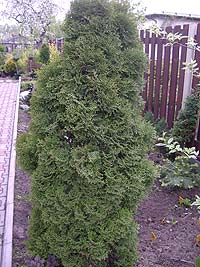 Thuja occidentalis "Holmstrup" Thuja occidentalis "Holmstrup"
Photograph by Oleksandr Zhukov "Holmstrup"("Holmstrup"). Danish variety in 1951 breed Breeder A. R. Jensen. Chagarnik. Height 3 - 4 m, crown diameter 0.8 - 1 m. The crown is finite. The bark of the chervona is grayish-brown, which can be seen. The needles are luscate, thick, green. Natural growth of frills 12 cm, frills 4 cm, normal growth. Tinevitrivala. To the soil it is not viable, to endure the dryness of the soil and the transcendental volatility, but let it be fresh, to add volatility to the fertile loams. Good to bear the haircut. Frost resistance. Zastosuvannya: single plantings, groups, living flesh, alleys. "Holmstrup vellow" - mutation "Holmstrup" with yellow needles. At the Botanical Garden BIN from 1992. according to winter hardiness, they do not fit into a typical wind tunnel. |
"Elegant", Witonchena ("Elegantissima"). Tree up to 5 m. The crown is narrow, wide-ended, thinned. The needles are zabarvlena brightly, bliskucha. Kіntsi pagonіv mаyut bіluvatiy vіdtinok. Zimost_yka. Fruiting well. Violently reproduces with live bait (up to 14%) and now. With sivbі more than part of the sіyantsіv declining signs of form. In the culture of the house since 1930. Recommended for single and group landings on the lawn.
 Thuja occidentalis "Ellwangeriana" Thuja occidentalis "Ellwangeriana"
Svitlin EDSR. "Elvangeriana" ("Ellwangeriana"). Transitional form, 2.5 m curl. The crown is broadly conical, in young trees it is pyramidal. Pagons are straight, fine-porous. Kіntsi hіlok strongly razgaluzhenі. The needles on young pagons are soft, golchasta, older ones are luscate, flat, pressed down, vzimku is siruvata. Zimost_yka. Reproduce summer (54%) and winter (97 - 100%) live bait, as well as nasinny. Vinikla in 1869, apparently, in Pivnichnaya America. Recommended for group plantings bіlya budinkіv yak solіter. Even thinned roslin for single plantings in the foreground. GBS from 1947 has 3 marks (16 notes) taken from Brno (Slovakia), the Netherlands. Tree, 49 years height 7.2 m, crown diameter 380 cm. Vegetation 18.V±10. Wider growth 8-15 cm. Do not saw. Winter hardiness is povna. |
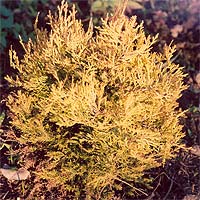 Thuja occidentalis "Ellwangeriana Aurea" Thuja occidentalis "Ellwangeriana Aurea"
Photograph by Popova Anetti "Elvangeriana Aurea", Elvangeriana Zolotista ("Ellwangeritina Aurea"). A yellow synovial mutant of the "Elvangeriana" form appeared in Shpet's breeder in 1895 (Nimechchina). Paste is povіlno and reaches close to 1 m in height, often there are sprat peaks. The crown is ovoid. The needles are luskopodіbna that golchasta, golden-bronze zabarvlennya, vzimku - golden yellow. Youthful growth of veins can make a garnier of erysipelas. Leaks are thin. Suffering from sleepy opikiv and sometimes from severe frosts. The streams thickly roar. Propagated by summer (52%) and winter (100%) live bait. Recommended for single and group plantings, for growing in containers. Even more decorative, miraculously join with the pyramidal green forms of thuja, kindly take care of the golden zabarvlennya. In GBS since 1957, 2 signs (11 notes) were taken from England, and the reproduction of GBS was growing. Tree, height 4.6 m, crown diameter 260 cm. Vegetation 15.V±10. Shhorіchny growth 5-8 m. Do not saw. Winter resistance of the temple. |
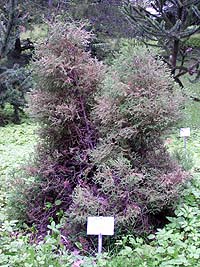  Thuja occidentalis "Ericoides" Thuja occidentalis "Ericoides"
Photograph by Zliva EDSR. Photo right Mironova Irina "Erikoides", Veresobrazna ("Ericoides"). Dwarf form up to 1 m. Guessing at the sight of yalіvets. The crown is rounded, wide-ended, rich-topped. Pagons are thin, gnuchki, straight and bent, numerical. The needles are awl-shaped, up to 8 mm long, soft, matte-yellow-green to the beast, gray-green below, brown. Shvidko growth. There are less decorative young growths, in old specimens there are a lot of old pagons and needles. Vіdoma like malozimostіyka form, bugatorіchnі pagony freeze. Easily propagated by live bait (88%). Effective in group plantings. Vykoristovuetsya at the creation of dwarf gardens and decorated flower beds. View from 1867 in St. Petersburg on the springs of E. L. Regel and K. Ya. Kes-Selring from 1901. At the crown, you can have a lot of dried-up pagons and needles; Found in collections botanical gardenБІН that science and research station "Vіdradne". GBS from 1957 p. 3 signs (8 notes) taken from Poland (sadzhantsi), from Lipetsk LSOS, Lvov, Sochi. Chagarnik, height 1.5 m in 20 years, crown diameter 80 cm. Vegetation 18.V±9. Large growth 3-5 cm. Winter hardiness is low. |
Roztashuvannya: you can grow on the sun at pivtin. On the sleepy areas Some people suffer from cold temperatures, or they get cold in the cold and dry up. It’s better to plant at the protection in the wind of the city. Zimost_yka (less frost-resistant deyak_ forms, we are ahead of the youthful juvenile needles, as well as golden deaks). Growth is good enough.
Priming: turf or leafy land, peat, sand (2:1:1) with additional additions when planting mineral fertilizers, 500 g of nitroamophoska on the skin has grown. You can grow on any kind of soil: swampy, peaty, clayey, dry soups thinly.
Landing: stand between roslins 0.5 to 3, rarely 5 m; an interval between trees of 4 m. Planting depth 60 - 80 cm fallow in the pile of earth, as well as the height and diameter of the crown of the growth. Rooted shiya on the equal earth. Drainage with a ball of 15 - 20 cm on the underlying clay or blow in trenches in the swamps.
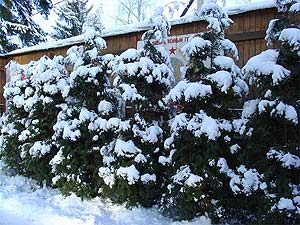 Zagorozh
Zagorozh
Photo of Solovyovo Deer
Overwatch: In the spring it is recommended to apply "Kemira Universal" with a spread of 100 - 120 g / m 2 only two years after planting, as it was added outside the mineral dobriva. The first month after planting, it is recommended to irrigate once a day, 10 liters per growing plant and carry out the finishing. In the dry season, watering 15 - 20 liters per roslin and 2 times per day, and also additionally. Tui love the waters of the soil, on dry places and in the shade of the crown they are happy. Rozpushuvannya neglibok 8-10 cm, so that the thuja can be superficial. root system. Bagan mulch with peat or trisco ball 7 cm. Haircut in livestock is dead, no more than 1 /3 dozhina vtechі. Crown molding as required. The growth has grown in full winter. In the first winter, after planting, young growth will require shelter. Protect your needles from winter and spring sony opikiv, vkrivayuchi spruce with spruce branches or craft paper.
Victory: туя західна та її форми являють собою найцінніший матеріал для зеленого будівництва на більшій частині території Росії, за винятком крайнього північного сходу європейської частини Росії, крайньої північної частини лісової зони Сибіру та посушливих південних степових та напівпустельних районів, де її можна замінити біотою. Resilience to the minds of the minds allows the breed to be widely planted in landscaped areas, and the diversity of decorative forms is great, giving the opportunity to create the most versatile compositions. In green life, it is planted for solitary plantings (especially garden forms), as well as for planting alleys, monumental walls and fences of various heights. In lіsogospodarskih tsіlyakh tsіkavit yak pіdlіsok breed і planting on supra-world water soils.
Partners: it’s good to go with hemlock, cypress, modern European, yalina similar, etc.
Thuja zahidna (lat. Thuja occidentalis), or life tree- Evergreen coniferous trees of the genus Thuya of the Cypress family. In nature, the species thrives on the gathering places of Pivnichnaya America along the low banks of rivers, swamps, on vape soils and water-borne loams. Roslina was described by Carl Linney in 1753, and it won its own name, as if it were translated from walnut, as “sacrifice, incense”; In these times, thuja is zahіdna, zavdyaks of their winter hardiness, longevity, resistance to toxic mіsk minds that great number piece-created decorative forms, wide-width nabula in all climatic zones.
Thuja zahidna - description
The height of the thuja zahіdnoї, tsgogo tree, scho povіlno growth, can reach 20 m, although specimens are sharpened and under 40 m of the crown. The root system of growing is compact, the crown is ovoid or pyramidal. In young trees, the bark of a red-borax is smooth, with an hour it becomes gray-brown infestation and begins to fade from the stovbur with late, narrow smugs. The upper side of the pagons is shiny, dark green, the lower side is matte and light. The needles are green; Live the needles of 2-3 rocks, after which you fall off at once from the sharp needles. The fruits of the thuja zahіdnoi are friable ovoid cones, which are formed from thin strips and avenge a pair of flattened nasіnnya with narrow strawy-yellow wings. The wood near the thuja is fragrant, red, visibly soft, aloe mіtsna and without tar passages. Goodness lies in the fact that she knows no rot.
Thuja zahіdna tіnevitrivala i zimostіyka, її pagony povnistyu zderev'yanyuyut. Roslina is a dovgovichna, st_yka to gas that dim and may ponad 120 decorative forms.
Landing tuї zahіdnoї
Thuja is absolutely unviable and can grow like a sun, and a bird. Roslin is impervious to the warehouse of the soil, it won’t be able to endure close to the rotting of ground waters, but on dry soils the needles of the tuї zahіdnoї blakne, the crown becomes rіdkіsnoy, and the roslin makes too rich cones.
Landing tuї zahіdnoї and watching her will not give you folding. When placing seedlings on a space, trim between them at an interval of at least 3 m, it is necessary to have tall forms in front of them. In livestock at noble settlements, there can be 50-70 cm between thujas, and 40-50 cm at single-row ones.

Landing tuї zdіysnyuєtsya hinged. Yami for the tsієї roslini is not obov'yazkovo to prepare a distant leg. The depth of the foundation pit is due to buti from 60 to 100 cm. On the bottom of the bottom, a drainage ball is laid with a bit of soil with a tovshchina of 20 cm, and then a hole for half the depth is filled with a prepared soil sum, which is made up of humus (3 parts), leaf parts of the earth (2 parts of the earth) , peat (1 part) and dog (2 parts) with additional 100-120 g of nitroamofoska.
Before planting, the root system of sapling needs to be washed in a container with water, so that the root is saturated with water. Then we will install the sadzhanets in the center with yami and fill the space, which is filled with the same lively soil. I will trample down the top of the grass and water it clearly. The root neck of the sadzhantsya is guilty of buti on one level with the surface. As soon as water climbs, barrel colo mulch with peat, humus with other organic material.
Looking after that zahіdnaya
How to virosity that zahіdnu.
The first month after planting, the thuja is watered sparingly, stained at a time with 10 liters of water. Youthful growth is necessary and the crowns of the watering cans with a shower head, like a zdiyasnyuyut after sunset. Take Vitrata for a shower procedure - 15-20 liters. During the dry period, the amount of water during irrigation increases to 15-20 liters per one bush, and the additional air is carried out for two days. After watering, the soil should be fluffed up to a depth of 10 cm.
Years of young growth of the first two rocks are covered with a complex mineral fertilizer.

Bigger grown up and mayzhe not vymagayut watch.
That zahіdnu needs to be protected from the spring opіkіv. For this spring of autumn, the stovbur is twisted with lutrasil or burlap, and the bright snowfall without breaking the tree hilt, they are tied with a synthetic skein or a twine. Young trees are now vkryvayut for the winter with spunbond or lutrasil.
Transplantation of tuї zakhіdnoi.
Looking at those who have a superficial root system, it is easy to endure a transplant. On the plots, on the ground, the waters lie lightly, it’s better to take that place at the spring, in other valleys you can take care of it and on the slopes. Transplantation takes place in the same sequence as the first planting: prepare a pit with the expansion of the root system of the growth, which is transplanted, lay drainage in it, prepare a soil sum. Once the thuja is picked up around the perimeter, stepping into the trunk 40-50 cm, pull it on a thin layer of polyethylene until a new month, work the root system with a root-crop plant (Kornevin) and then plant it.
The first hour after the transplantation of thuja zahidna will require frequent watering and obov'yazkovogo protection from the sun.
Ailments and poor people tuї zahіdnoi.
Most often, at that windy storm, or the frogs and chicks swell. Illness is caused by fungal infections.
Storms of fire: early spring on the roslini zhovtіyut okremі lusochki or golki, and pіznіshe all vtechі vtechі і vіdmiaryut. It is necessary to see such pagons negainoly, and the skin of two tizhnі z lindens on the zhovten is covered with two hundred rosin Fundazol.
Usikhannya pagoniv: this phenomenon may have two reasons: a blocked root and fusarium, or tracheomycosis, which is caused by soil fungi. A back on the growing line and falling leaves, a storm of young growth, and after it the tops of mature pagons, and ce tell about those who pozhivnі speechovina stopped coming from root to crown. As the nature of the fungal phenomenon, that zahіdnu and grount navkoly it should be treated with dvovіdsotkovym Fundazol or a similar preparation: Kartocid, Abiga-Pik, HOM. At the same time, follow up on the growth of fungal infections with Zircon. In the yakost preventive entry Vykorovuyut regular processing of thuja from spring to autumn with Tsineb or copper-containing preparations.

From the time of shkіdnikіv nebezpeku for tuї zahіdnoї to become tuєva popelitsya, tuєvi false shields and moth-moth.
Moth moth the size is close to 4 mm, but in the її shkіlії dіyalnostі lіyаlnostі lої tuї burіyut, and the tops of the pagonіv vіdmirayut. The larvae of the moth grow near the needles of the crying walk, in view of which the growth begins to chiritis. In order to prevent the spreading of blizzards, it is necessary to use two worms for example, in the interim for a week to treat the plant with pyrethroids - Cypermethrin or its isomers.
Tueva population drink the juice of the needles, through which the luski zhovtiyut and fall off, and the decorativeness of the growth is sharply reduced. Rising the popelitsa with the help of tuy Karbofos, moreover, it’s better for everything, that one appropriation will not be enough.
False shield so the head of that great shkodi, appearing on the roslini near the grass-chervnia. More than a thousand eggs may appear in one clade. The larvae begin to grow the needles of the thuja already in the lime: in the area of their residence, the needles look chlorotic. In order to protect that zahіdnu vіd false scales, її spray with preparations Actellik, Rogor, Antio or Karbofos until the opening of brunok and vlitka, for example, chervil or on the cob of lime.
A cut of that zahіdnoy
Thuja zahіdna zovsіm not be afraid of pruning, prote the following to know a sprat of simple rules, yakі will help you to trim the roslin in the best form. The crown of the skin s decorative variety of thuja in the process of growing grows into a singing geometrical form: є thuja is an inward culast, є pyramidal, ovoid and columnar. Vykhodyachi zgogo, especially the need for shaping the tree is not, so only you did not virish to give that form, which is not powerful for the variety. However, the sanitary cleaning of the crown is necessary for any kind of mood. How to establish the rules for trimming zahodnoy tuy?
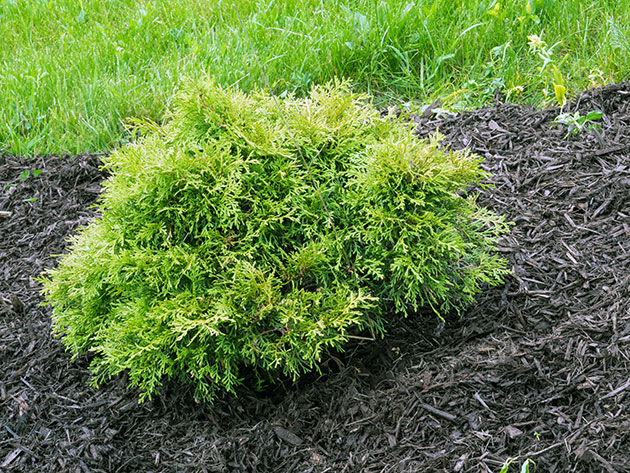
You can trim the bush in early spring, in the fall of that autumn in gloomy weather, the shards of sleepy trees hang dry when the needles are sheared.
Be-yaké circumcised, in that number and form, obov'yazkovo s vydalennya ailments and dry chicks, after which it is necessary to treat the growth with a fungicide.
The sights on the needles of the zahodnoy thuja do not need to be dressed with garden var.
Reproduction of tuї zahіdnoї
Nasіnєve reproduction of tuї zahіdnoї.
Vityagnut zі svezhozіbrannyh i vysushennyh buds nasіnnya tuї sіyut near the soil for the winter, so that the stench in the cold earth went through natural stratification. For this wooden box, it is reminiscent of a watery sum of garden or soddy land (1 part), peat (2 parts) and sand (pivchastina), spread on the surface, scatter furrows at it with an interval of 5-6 cm, and sow the soil in it. Depth of throatiness - 1 cm. The box is installed near the dark trees and vkryvayut in the creatures with lutrasil, but it is necessary to follow it, so that the stump does not stick to the soil in the box.

The first time to get off the shore is 2-3 days after the earth warms up to 10-15 ºC. Give respect to the fact that the needles of the syants are holchast, and not luscious, like those of mature roslins. For a month, go away for a month with a full mineral fertilizer, and if you become a tight box, hang siants on a school garden, plant in a pivtin. At the soil on the beds, it is necessary to add a bucket of humus in front, 250 g of wood ash and 40 g of nitroamophoska into a 1 m² spreader. The transplantation of syantsiv is done according to the scheme 30x30 cm. The root neck can be on a flat surface. After planting, water the bed and mulch the surface with organic material. Keep watering and pіdgodovuvat sіyantsі z ієyu w regularity, fluff the soil around them, and on the third river, if the young ones reach a height of 50 cm, you can hang them on the bed.
Reproduction of thuї zahіdnoї with wooded live bait.
Form that variety of tuї zahіdnoї multiply livestock. Like living vicarious woody vines of two-three-tree pagons with a length of 25-40 cm, or like woody vines of growths of flowing rock with a length of 10-20 cm, like sprouts from worms. The living things are harvested from the stump, so that with a small piece of needles, in the event of a wind leak. The lower part of the live bait is cast in the form of needles and needles, and the lower part is covered with heteroauxin, after which the live bait at a cut of 60º hangs near the greenhouse in the sum of the river sand, peat and turf land in equal spіvchinyshchob on such a basis. . Depth of planting vіd 1.5 to 2.5 cm. It is also important to keep the greenhouse temperature at 23 ºC and high water content repeat (between 70%), and for which the watering of live bait is replaced by regular watering. If the baitfish are rooted, we can look after them in airing, watering and reviving, and if you are inspired by what the stench is to harvest, you can hang them on the bed. In leaf fall, live bait is insulated with thyrso, the leaves are either with yalina spruce branches, and in the cold weather -5-7 ºС, they are additionally covered with plіvkoy.
Sort tuї zahіdnoї
Numerical decorative forms of tuї zahіdnoї are subdivided into five groups:
- - group A: the height of which is typical for the appearance of green needles, like a collection of brown zabarvlennya. The columnar forms (Columna, Filiformis, Pendula, Fastigiata, va Stricta, and Malonyan), the loosely knotted (Bodmer, Douglas, Spiralis and Pyramidalis) and the special forms, for example, vuzkobladnіdnі wide-pointed , Smaragd, Goetz Wintergreen);
- - group B: dwarf tuy with green luso-like needles. Up to the level of the zokrema group, one can see the thuja with an ovoid and round crown (Danika, Globoza, Getz, Little Champion, Rekurva nana, Little Jam, Midzhet, Dumosa), thuja, the crown of such a stack of pin-shaped only with a vіkom (Secrets Tim, Umkuvarda) ) that thuja with a handful of pin-like crown shape (Holmstrup, thuja Rosenthal);
- - group B: thu with stringed luso-like needles. For example, thuja with yellow needles (Close of Gold, Golden Globe, Lutea, Lutea nana, Sunkist, Vareana lutescens, Semperaurea, Yuerep Gold) and thuja with stringy-white needles (Meinekes Zwerg);
- - group G: form with simultaneously luscious and bare needles (Ellvan geriana, Elvan Aurea, Reingold);
- - Group D: thuja with thorny needles (Erikoides, thuja Ohlendorf).
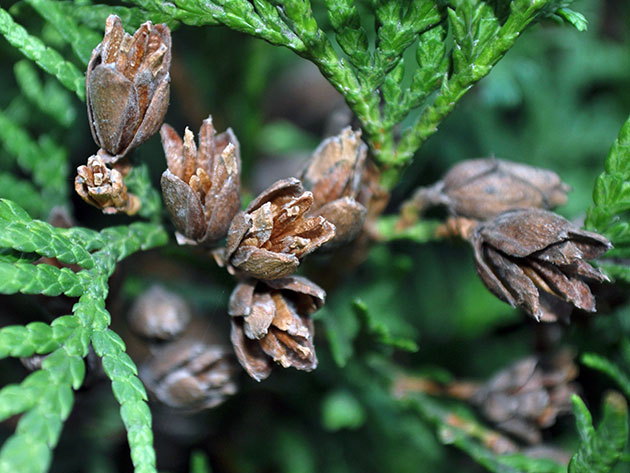
We suggest to you the varieties of those zahodnoy, which are most often grown in culture:
- – thuja zahidna Smaragd- additive roslin of Danish selection with a height of up to 2 m with a cone-shaped shape and weak shading. The pagons at the roslina are streaked vertically, and the glossy, green, and swirling, and the inlet of the needles stand far away, one and the same. Decorativeness at the growth of the temple;
- – thuja zahidna Brabant- A tree with a height of 15 to 21 m with a terminal crown with a diameter of 3-4 m. Cones dovgasto-ovoid, brown. The needles are luscious, green, which saves the zabarvlennya to wind a narrow;
- – thuja zahidna Bowling Ball- Dwarf roslina with a practical kulasty crown. The needles of the cієї form are soft, luscat, thread-like, dark green, vzimku with a light bronze vіdlivom;
- – thuja zahіdna Danika - tezh dwarf variety, visions of 1948 rock in Denmark. Roslin reaches a height of 60 cm, and the diameter kulyastoy crown become 1 m. Danika's bark is sharovuetsya, gray-brown or chervonuvata, needles are luscat, soft, thick, bliskucha, green, and with a brown vіdtinkom;
- – thuja zahidna Aurea- small or medium roses of roslin with golden-green needles, sometimes bushy-shaped. Crown of the same variety in the form of a wide cone;
- – thuja zahidna Woodward- Roslin with a height of 1.5 to 2.5 m with a stalked crown with a diameter of up to 5 m; In a culture variety from 1923;
- – thuja zahidna Globoza (abo Spherical)- The height of the growth is 120 cm, the rounded crown reaches a diameter of 1 m. Densely planted pagons rise uphill, luscious needles with gleaming inlets are green or gray-green, and brown in the winter hour;
- – thuja zahidna Golden Globe- ce mutation of Woodward's thuja with a rounded crown and yellow needles;
- – thuja zahidna Miriam– a variety of the variety Danika, which is quite mature pygmy chagarnik with a bowed slit crown with a diameter of about 80 cm.
- – thuja zahidna Columna- a fairly growing tree, reaching a height of 10 m. The crown is columnar, the bark is short, red-brown, the needles are thick, luscious, bliskucha, the cilium river is dark green;
- – thuja zahіdna Mystery Tim- even more beautiful, albeit more and more growing dwarf roslina, bred in 1955. At height, it reaches 50 to 100 cm, and the diameter of the stalked crown is 1 to 1.5 m. dark green color;
- – thuja zahidna Holmstrup- a variety rejected by Danish breeders in 1951. Tse chagarnik with a height of 3-4 m with a terminal crown with a diameter of up to 1 m, a red or grayish-brown bark, which can be seen, and thick, luscious needles of a green color;
- – thuja zahidna Teddy- a new variety, like a shvidko, becoming popular. This is a dwarf chagar, which is of sufficient growth, with a cushion-shaped crown and non-thorny needles of a dark green color, like a brown widow;
- – thuja zahidna Yellow Ribbon- A small tree with a finite crown shape. The needles on the pagons of flowing rock are bright-zhovt, mayzhe orange, ale step by step it becomes light green, and until winter it becomes bronzed.
Coniferous trees may be especially valuable for landscape design. It is widely used for landscaping public gardens, parks, gardens and, obviously, garden plots. Moreover, garni stinks like in single plantings, so in group compositions. Not a crossroads coniferous roslinє їх zdatnіst save greenery to wind up at the winter time of rock.
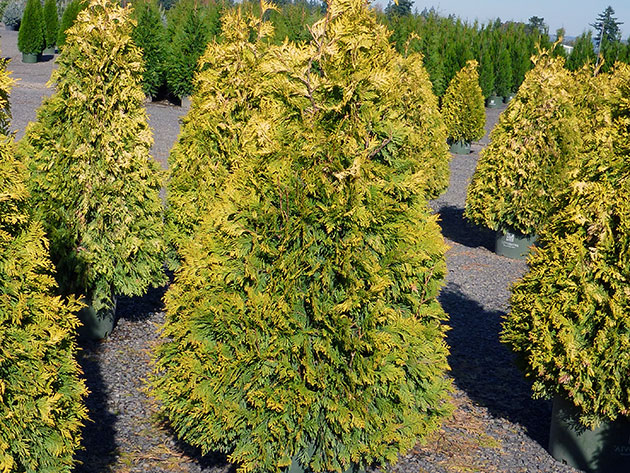
In the midst of the impersonal coniferous trees, thuja thrives among designers and gardeners with the greatest popularity in Persh Cherg. High-growing strings of thuy vicorist for livestock (Brabant, Smaragd, Holmstrup), forms with a stalked crown often planted on lawns like salty growths (Danika, Tainі Tim, Teddi), and dwarf varieties grow in rock gardens and rockeries.
Rating 4.90 (10 vote(s))Thuja is an evergreen coniferous tree that can be traced to the cypress family.
It is a tree or a chagarnik with luscious leaves and bark, which roztreskuetsya. The crown is wide, dense, the trees grow in the same plane. In young specimens, the needles are hollow-shaped. The color of din roslin varies from low green to red. Іsnuє anonymous two-coloured rows of zabarvlenyh varieties.
Head photo of Thuja occidentalis "Golden Smaragd".
For the form of the crown, the thuja is subdivided into:
- columnar;
- pyramidal;
- wide-ended;
Thuja is columnar - compact roslina, 1.5-2.5 m of the crown and 0.5 - 0.8 m of the crown.
Varieties of columnar form
"Brabant" (Thuja occidentalis "Brabant")
Up to 10 years of growth over 3.5 m, 1 - 1.5 m tops. Shvidko growth, the form is wide-columnar. Increment per river 30 cm. Vіdmіnno pіdhodit for molding livestock. Width of landing in a row 0.5 - 0.7 m.
"Yellow Ribbon" (Thuja occidentalis "Yellow Ribbon")
Up to 10 years of growth up to 2 - 3 m, 0.8 - 1.2 m tops. The vuzka is of a finite, non-schilna form and the bright-zhovta needles. To love life-giving soil. Looks striking in contrasting color compositions, ideal for tapestries. 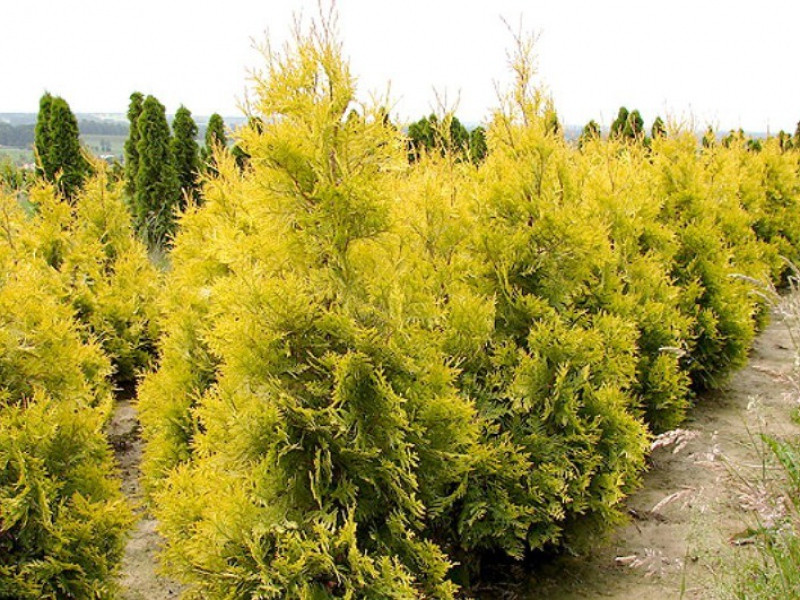
Columna (Thuja occidentalis Columna)
Up to 10 years it grows up to 3 m, 0.5 - 0.8 m of the crown. Shvidko growth, crown vuzko-kolonopodibna. The leaves are dark green. Vibagliv to the minds of the viroshchuvannya. Garno looks like a living creature, and like a vertical dominant in landscape compositions. Visajuvannya in a row for a width of 0.6 - 0.7 m.
"Smaragd" (Thuja occidentalis "Smaragd")
In 10 rocks it grows up to 2.5 m, for a width of 0.5 - 0.8 m. The crown is vuzko-columnar. One of the most popular varieties. The needles are dark green, not a storm. Vibagly vіdnositsya to the soil and to watering. Vykoristovuyut for single plantings. When hanging in a row, distances of 0.5 - 0.6 m are added.
"Aurea Piramidalis" (Thuja occidentalis "Aurea Piramidalis")
At 10 rokіv the height is up to 2.5 m. Flows of gnuchki, slightly twisted. Ideal for hanging in a group and as a saltire. Vibagliv to the soil and watering.
"Holmstrup" (Thuja occidentalis "Holmstrup")
In 10 rocks, it grows up to 2 m, 0.5 - 0.8 m of the crown. Growth is povilno, the form is vuzko-kolonopodibna. Pagoni grow languidly, thick needles of intense dark green color. To love life-giving and vologous land. Suitable for single plantings and compositions, flowers. For living creatures, stand at the row to become 0.6 - 0.7 m. 
Thuja warehouse "Aurescens" (Thuja plicata "Aurescens")
Height up to 8m - 12m, 3 - 4m width. An evergreen columnar tree with dense bushes. The needles are dark green, with white husbands. Vibagliv to the warehouse of the soil. Suitable for large-scale gardens and parks, group and single plantings. 
Thuja warehouse "Excelsa" (Thuja plicata "Excelsa")
Height 9-12m, 3-4m wide. The tree grows in the form of a colony with arched uphill straightened needles. The needles are dark green, thick, glossy. To love living quarters. Suitable for expanses of gardens and parks, solitary and group plantings, and for vertical accents in tight landscape compositions. 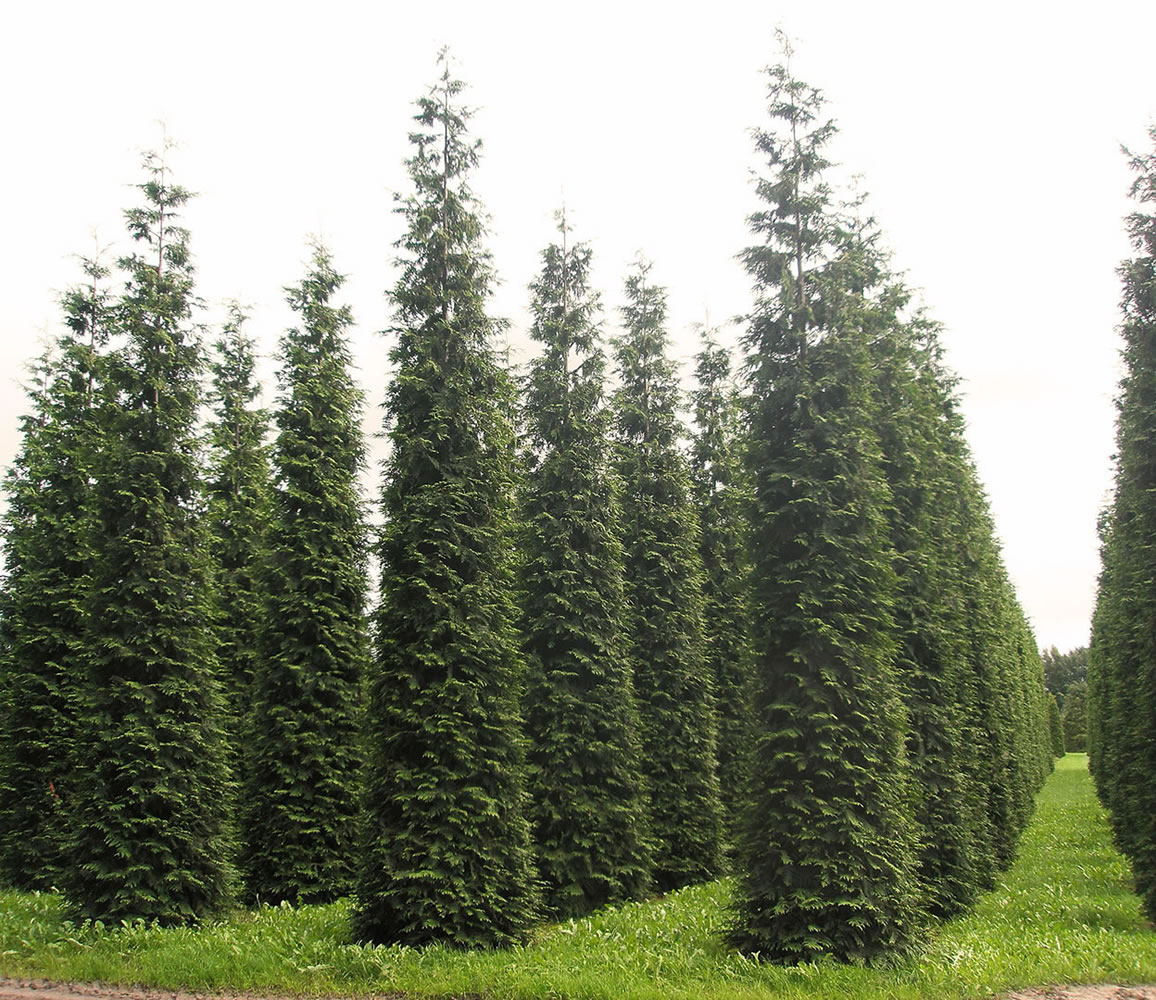
Landing
Tui older than 3 years old hang out with a saved breast, figuring out which is due to grow about half the diameter of the crown. Rosemary for planting should be made from 60 to 100 cm for rosemary with a diameter of up to 3 m.
Important: when planting in the soil, the root neck is to blame buti on equal ground.
It is necessary to hang the head of the head in such a way that the root neck was about 5-10 cm taller than the earth, because. after watering, the soil is strengthened and settled.
For planting, take soil sumish from soddy or leafy land, peat and sand in a proportion of 2: 1: 1.
Obov'yazkovo vikoristovuvati complex mineral supplementation (nitroamofoska and other) - approximately 150 - 200 g per planting hole. Mixing them in front with the soil.
After landing of shoes bright watering- Not less than 2-3 winds lead to a pit for a mature sapling.
Porada: to improve the development of the root system and increase the amount of preparations of the "Kornevin" type.
Dogliad
In the first month after planting on the post-plant, it is watered 1-2 times per week, approximately 1-3 zebras are not grown. If the planting was carried out on a hinged surface, then for survival it is more pleasant to touch the crown.
Respect: in order to protect the vtrati vologa, they should mulch near the trunk of the colo.
For this purpose, the bark of conifers, water peat, leafy humus, garden compost, and needles are vicorated. In addition, the mulch, spreading out, serve as life for the roots, and also protects from the freezing winter.
Thuja may have a shallow root system, henceforth, it is necessary to take care of the water content of the soil. In case of insufficient watering or drying out, the crown can often become sagging and rotten. In the period of growth, the trees are watered for the day, 1.5-2 buckets of water per sapling.
During the process, it is necessary to fluff up the soil to a depth of about 10 cm.
For a safe winter, wrap it up with agrofibre. Tse to ensure її vіd podmerzannya, dormouse opіkіv, і vіd rozstrіpuvannya kroni with snow.
Life
As soon as the roslin is planted in good soil preparations, then it will be enough for 1 - 2 regeneration on the river. It is necessary to add nitrogen mineral fertilizers (ammonia and calcium nitrate, sechovin) in spring. Naprikintsі lita - calcium and rejuvenation, to avenge phosphorus (superphosphate, nitroamophoska)
Dobre pratsyyuyut complex pіdzhivlennya for coniferous roslin trivaloї dії, for example "Kemira" and "Osmokot".
It is important to know: if you have made a landing on the first hour of landing, then it will come to life in 2 years.
Reproduction
Reproduction of thuj is carried out in two ways: generative (sowing for the day) or vegetative (cuttings).
With the vegetative method of reproduction, young roslin is more likely to take the characteristics of the mother. Generative way to stagnate all types of conifers. However, it is not enough that wine does not guarantee the conservation of varietal qualities of certain forms and varieties.
So, for example, hanging on that column-like, column-like shape of the crown, not all the radiances fall, but only an insignificant part of them.
Viroshchuvannya іz nasіnnya
Tsey way to do it laborious, prote allows you to take a lot of strong beautiful roslins.
In spring, it is necessary to pick up the bumps that have grown on the thuja and place them for a certain hour in the warmth dry place. If it doesn’t dry out and opens up, it’s necessary to pick it up, put it in a paper bag and put it in the refrigerator until spring.
There stink to go through the process of stratification. Tse to paint their similarity, stamina to ailment. Before sowing today, it is recommended to soak for 12 years in warm water or a wet dog. 
The second transfer option sowing on autumn.
On selection for sowing the beds, it is necessary to spread the soil, add sand and leafy humus. To break up the earth with a light and porous penetrating one, by the same token to paint the development of the root system of future growths.
Settlement of the last day for the scheme of 8 divs for 20 divs (inter-row), depth 1 div.
Cover the winter bed with a sackcloth and spruce branches, as it will be necessary to tidy up in the middle - for example, birch.
Today, the dawn of autumn, it will rise, as soon as the earth warms up to 15 - 20 degrees.
A closer look at the signs includes a one-time boost with a stimulant for growing roots, and periodic boosts (1 time per month) with fertilizers for growing, for example, Kemira or Agricol.
Do not forget to apply preventive treatment against fungal infections with fungicides.
Sіyantsі require a steady coat and light fluffing. Let's not get young and grow mulch with thyrsus.
The growth of the first rock becomes close to 8 cm. 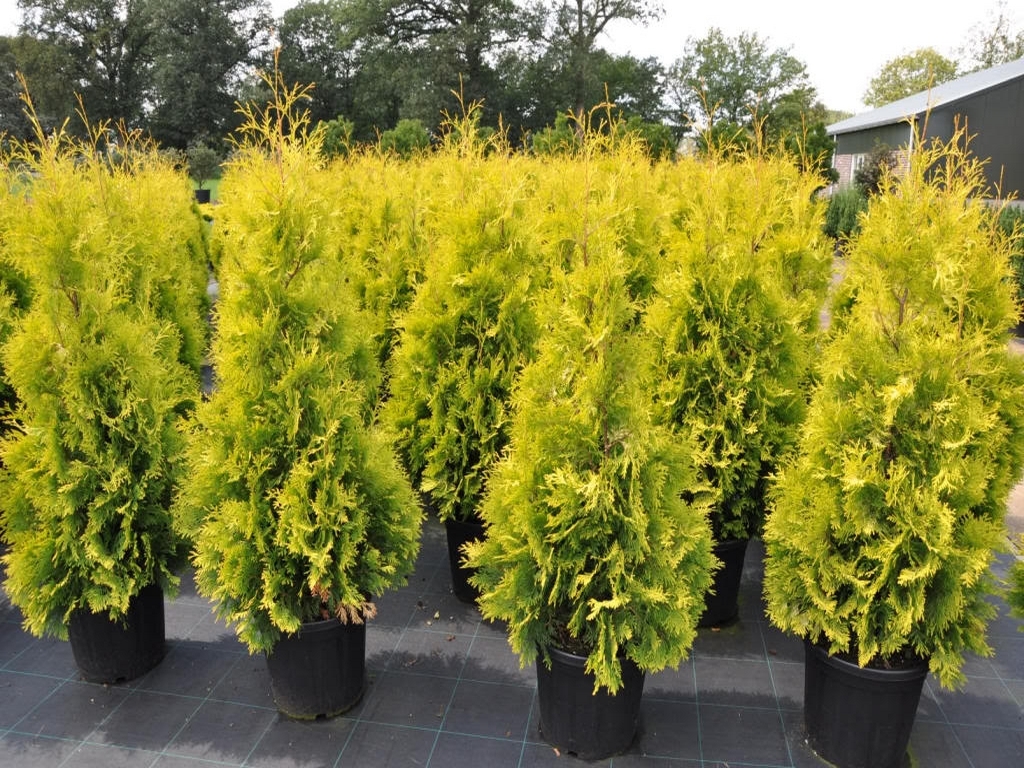
Skіlki koshtuyut sadzhantsі
The assortment of coniferous roslins is wide and varied.
The price for planting tuї zahіdnoї to lie down according to a specific species and variety, as well as according to the size of the planting.
Thuja zahidna Smaragd- From 200 rubles for small growths with a height of 15 - 20 cm up to 6000 rubles for growths with a height of more than 2 meters.
Thuja zahidna Braband- From 180 rubles for a 15-20 cm sapling to 3300 rubles for a 2 m sapling.
Thuja zahіdna Columna- a meter-long sadzhanets cost about 750 rubles, a two-meter one - 3300 rubles. Sadzhanets 15 - 20 cm cost about 180 rubles.
Thuja zahidna Holmstrup- Sadzhanets 0.2 - 0.4 m of the veil koshtuvatime between 420 rubles, and 2500 rubles for a copy of 160 - 180 cm.
Thuja zahidna Aurea Piramidalis- 320 rubles for a sapling 0.15 - 0.20 m and more 4000 rubles for a sapling with a height of 2 m and more.
How to stop in landscape design and how many gardeners are needed
For landscaping, the selected plots of trees play the role of:
- living fence;
- single trees;
- group landings.
For the formation of livestock, take such a look, like Smaragd, Braband, Yellow Ribbon, Columna ta іn Sadzhantsi hang on the vіdstanі 0.5 - 0.8 m. decorative look tsiliy rik.  Tuy Excelza, Aurescens suitable for group and single plantings, large-scale gardens and great parks, shards and tall plants. Up to 10 years, the stench grows up to 8 - 12 m, 3 - 4 m of the top. In a group, plant with a winder 5 - 8 m.
Tuy Excelza, Aurescens suitable for group and single plantings, large-scale gardens and great parks, shards and tall plants. Up to 10 years, the stench grows up to 8 - 12 m, 3 - 4 m of the top. In a group, plant with a winder 5 - 8 m. 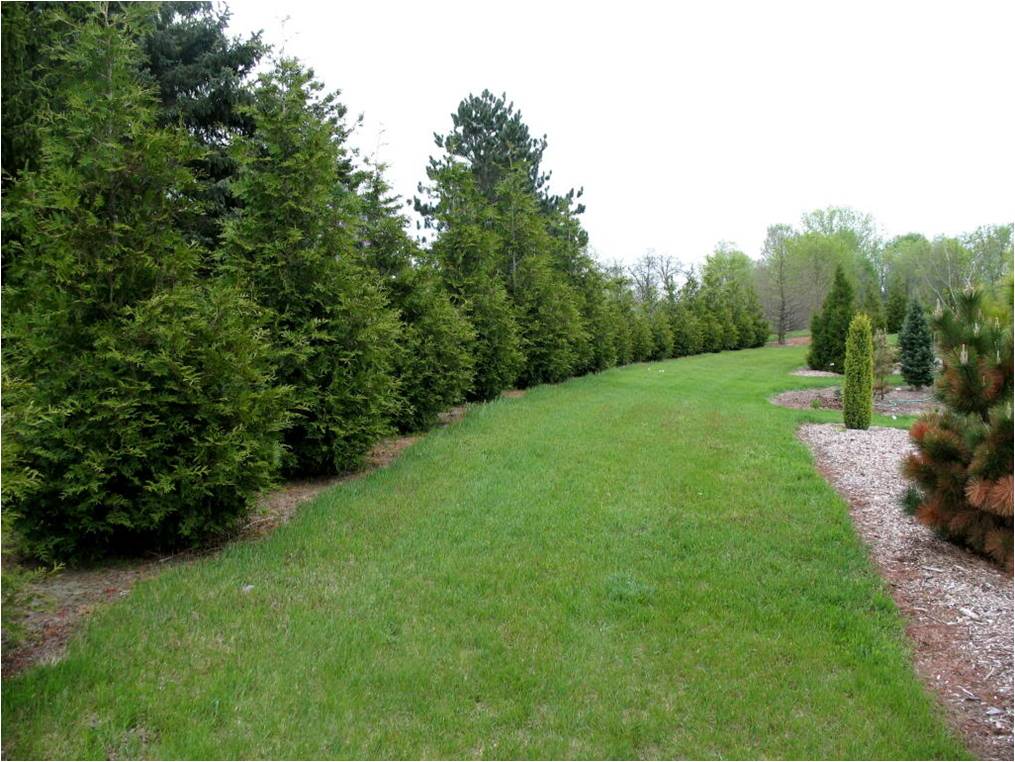
For і small pіdіdіdut low-growing dwarf varieties: Aurea Piramіdalis (), Holmstrup (Holmstrup). Up to 10 river vіku tsі vidi reach trochs larger than 2 - 3 m and have a crown width of 0.5 - 0.8 m. 
When landscaped country houses, yards, flowerbeds of the city, it’s good to vikoristovuvaty one hour a sprat of seeing thuja, creating different compositions (photo). When planting, protect the growth of skin growth in a mature person, reserving space for growth. 
Kindly pick up the conifers of different colors for the shape of the crown and the color of the needles (photo), pick up the greens and lines, as well as the double-coloured varieties. 
The first thing to do is start working, kindly lay down the scheme of the possible flower bed, so that it would be easier to visually reveal that the layout of the placement of the roslin and the roaring of the country and the countryside between them. An example can be a photo of the below diagram: 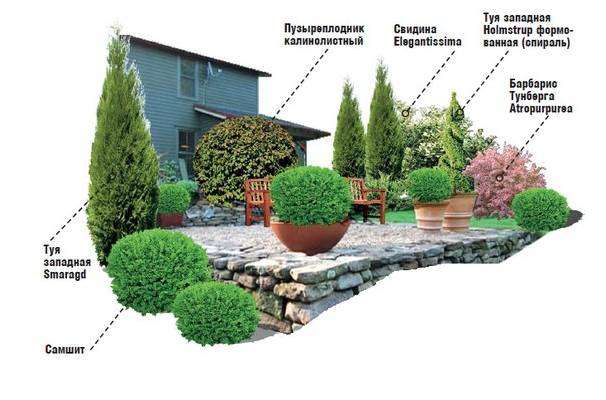
Because of its decorativeness, inconspicuousness and diversity, the pyramidal thuja has become an absolute favorite in landscape design. It miraculously looks like solo, and in, and in plantings at once with other conifers, and also at the same time with single and rich deciduous roslins. The thuja is pyramidal in nature at all stages of its life, without losing decorativeness and in old age.
How not to get lost in the diversity of tui?
In these articles, they reportedly looked at just one form of tuyi - columnar. On the video below, the garden center Greensad acquaint gardeners-pochatkivtsiv with the variety of arborvitae.
Thuja is often used in landscape design in rich parks and squares, in dachas and home garden leather is another gentleman growing evergreens of the cypress family. Varieties grow in their own diversity, the clumps look aesthetically pleasing, dwarf thuja easily fit in flowerpots on the streets, which grow quickly and are valued by gardeners, but blackberry beauty, or with yellow needles, navіtna tasting a golden garden.
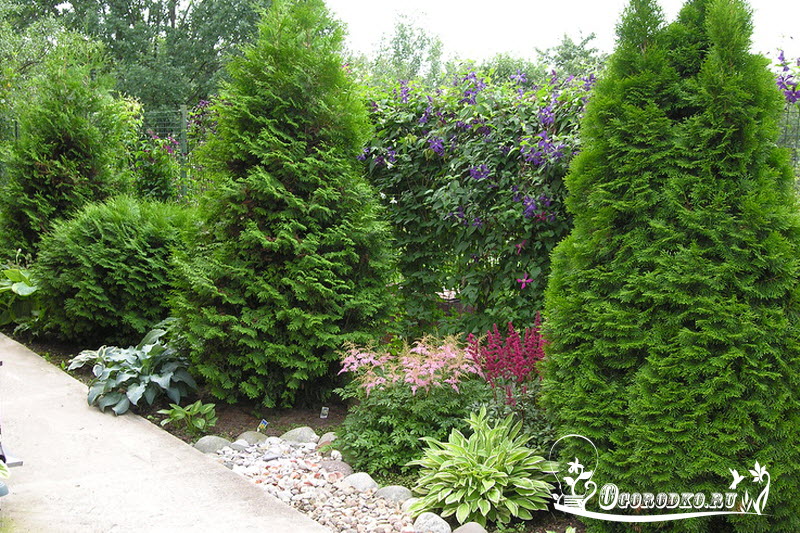
Brabant
Thuja Brabant (Thuja occidientalis Brabant) is a tall columnar bush, reaching a height of 4.5 m and a width of 1.5 m. Zabarvlennya malachite, vzimka z'yavlyaєtsya trohi brown vіdlivu. Brabant is a variety that is fast growing, grows at a height of 0.3 m beyond the river.
Nevibagly at the watchful eye and viroshchuvanni, it is easy to blame the cut. It can be cultivated on wet and dry lands, or rather, loams with good kinship are suitable.
After landings in vіdkritiy ґrunt it is recommended to hide from the yaskravih sleepy shifts vzimku that early spring. Roslin to finish the tіnyovitrivala, often hang around like a garn I will fence. They also create garni compositions on garden plots, in Moscow public gardens and parks.
The correct planting of Brabant conveys the presence of digging, in the yak they lay the sum of the native soil (2 parts), the river sand (1 part) and the peat (1 part). In addition, it is recommended to bring in mineral goodness and stitches behind the root neck, as after the landing one is guilty of being on the right side of the earth.
The fence is alive to go out with a strong and narrow, if you grow up at a planting of 50-70 cm.
 A block of living fences from the entryway "Brabant" - on the photo
A block of living fences from the entryway "Brabant" - on the photo 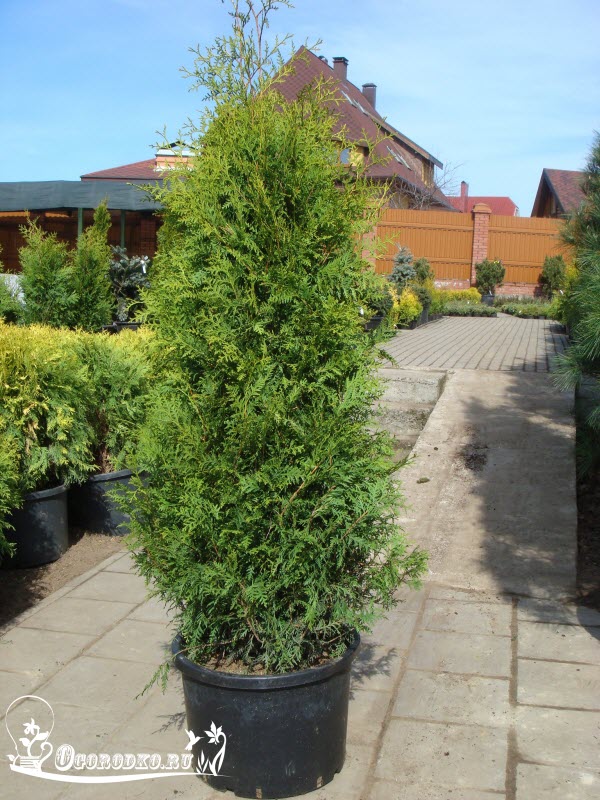 Thuja Zahidna Brabant.
Thuja Zahidna Brabant.
Emerald
Thuja Smaragd (Thuja occidientalis Smaragd) is characterized by a slow growth rate and is respected by a good end chagar. The grown-up individuals may have a height of 2.5-4.5 m, a diameter of 1-1.5 m. Stіykіst up to the frost of the temple, zabarvlennya from the coming winters do not change. When victorious thuy Smaragd in life, it is necessary to lie, that the tops do not flicker in the mountains, that separation of space is worth being smart.
 Thuja zahidna Smaragd Marianna - on the photo Tuya zahidna Smaragd - on the photo
Thuja zahidna Smaragd Marianna - on the photo Tuya zahidna Smaragd - on the photo
Through more growing growth, the procedure of shearing is frequent, which is a great advantage over other varieties. Good virosta on drained soils, do not endure drought, it is necessary to know, in the garden, to ensure garnish color that healthy growth.
Plant that Smaragd better on missions, like protection from strong winds. When planting on bare dormouse plots, you can suffer from temperature changes, you should take care of young bushes in the sun.
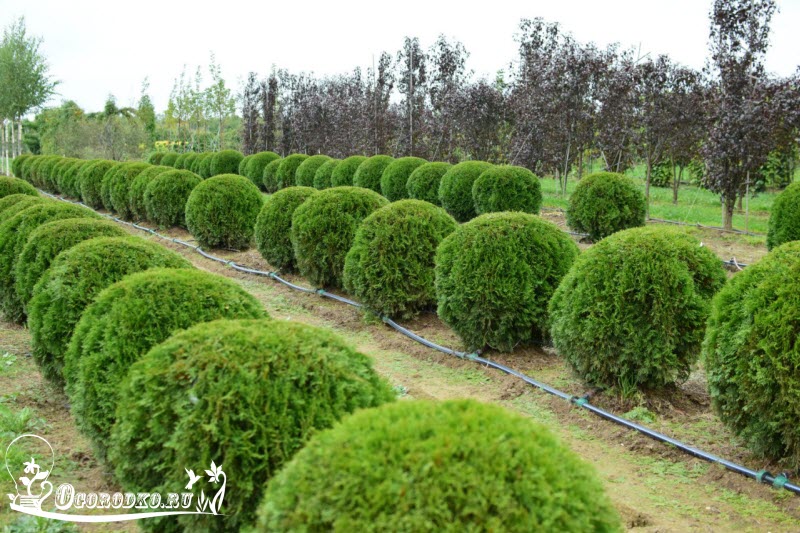 kuli z tuї zahіdnoi Smaragd.
kuli z tuї zahіdnoi Smaragd.
The optimal acidity of the soil for growing thuja is 4.5-6 Ph. When the groundwater is close to spreading, it is necessary to lay a drainage ball made of crushed stone (chipped pebbles, pebbles) with a 10-15 cm diameter.
Columna
Thuja Columna (Thuja occidientalis Columna) is an upright tall chagar plant (3-5 m) of a columnar narrow shape. Dosit medium height, grow 13-15 cm on river. Do not use color in the winter period. The needles are luscious, glossy, garnet shimmers on the sonechka.
Columna is a winter-hardy representative of cypress conifers. Before the soil warehouse, the beauty is not primhliva, it is not good to feel in pіvtinі. Suitable for organizing a green parkan at the dacha or garden plot. Vletka through the lack of water can get in and out of the gloss. Vіdmіnno pіddaєtsya obіzannyu.
 Thuja Columna - pictured
Thuja Columna - pictured  Thuja Zahidna Columna.
Thuja Zahidna Columna.
When molding beautiful fences, distances of 60-70 cm between plantings are trimmed. It is necessary to remember that the bright sun did not sap the young bushes in the first sprat of the rocks. Column vikoristovuetsya gardeners for topiary trimming.
Holmstrup
Thuja Holmstrup (Thuja occidientalis Holmstrup) - columnar, small stalks. The curly hairs look exceedingly beautiful in the living fences and in the artistic garden elements. During the winter period, the fermentation does not change.
 thuja zahidna Holmstrup.
thuja zahidna Holmstrup.  thuja zahidna Holmstrup.
thuja zahidna Holmstrup.
Frost-resistant thuja, without problems to endure sheared needles that have grown. Holmstrup - growth is povіlno (rіchny growth up to 12 cm). If cultivated in fences, it is recommended to cut it every two years.
In places with sufficient lighting, there are more and more windmills of pagons, but in pivtiny, the roses are not attached. To bring the unviable to the water, small stagnations of water are not terrible. On dry land, it consumes turgor, recommended by the Vologda Grunti. Vymogi to warehouse similar soil, as well as to other varieties and varieties of western conifers.
Fastigiatu
Thuja Fastigiata (Thuja occidientalis Fastigiata) is a cypress conifer characterized by a columnar crown. The vіdgaluzhennya is thick, the growth is compact, pofarbovanі in the juice of the grapes. Height 5-6 m.
Fastigiata - a variety of thuja, which is fast growing, growing by 0.3 m on the river. Needles of soft structure with characteristic odor. Nevibagly, it is easy to get a haircut, and it grows up after a long bunny hair.
 Thuja zahidna fastigiata.
Thuja zahidna fastigiata.  thuja zahidna Fastigiata.
thuja zahidna Fastigiata.
Cypress is similar in its shape. Vikoristovuєtsya when building green fences, so that enough height and width allow you to take a thick fence. Visajuvati bazhano on dressing drained loams with dead water.
Sunkist
Thuja Sankist (Thuja occidientalis Sunkist) - a small coniferous tree (3.5 m) with a characteristic conical crown, de-gilled. Young saplings are poached in a yellow color, shimmer with a golden hue, turn lemon-yellow in the course of the year, and commemorate bronze tones. Examples that grow in darkness are more important than green.
Variety Sunkist - fully grown, mature bushes (very 10-12 years) two meters tall. Frost-resistant, liberal to soil warehouse. Suitable for embellishment dacha plots, miraculously looking in alpine gyrtz, different compositions and like a single one.
 thuja zahidna Sunkist.
thuja zahidna Sunkist. 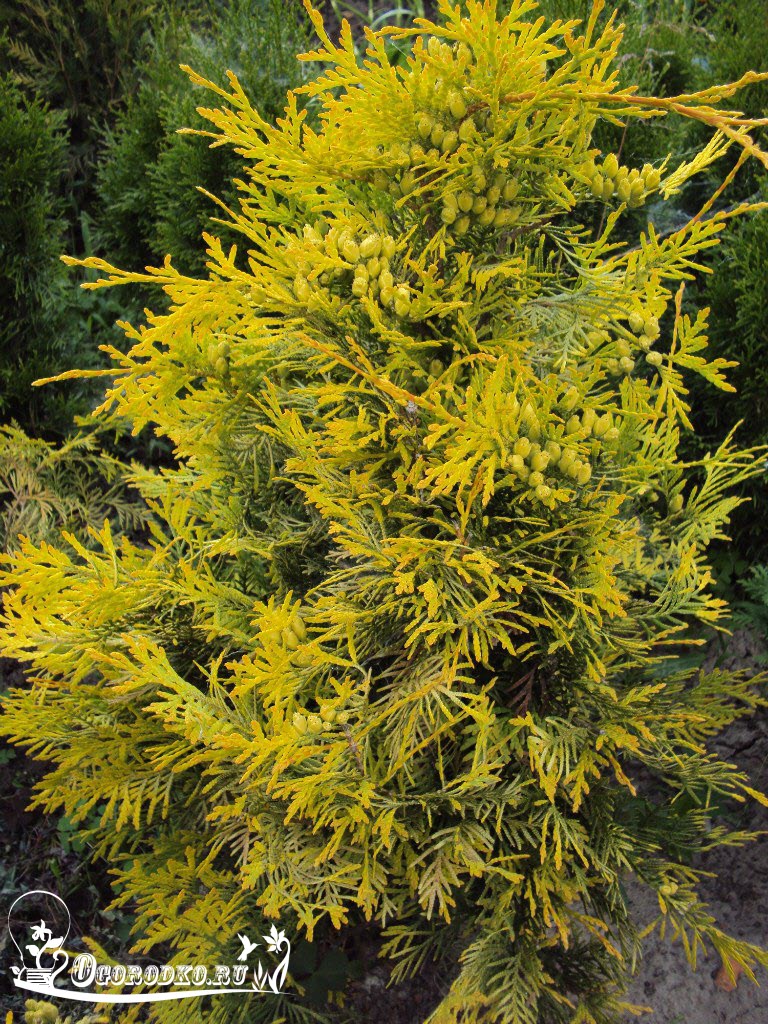 thuja zahidna Sankist.
thuja zahidna Sankist.
It is worth cultivating the minds, vibrating to the moisture and fertility of the earth, when planting, it is necessary to vicorize peat krichta, river sand, germinal soil (1: 1: 2). Recommendations between bushes - 50-60 cm.
Wagneri
Thuja Wagneri (Thuja occidientalis Wagneri) - deadly height (3.5 m), the bush is strong and thick, ovoid. The little tree is rich, growing uphill, which gives neatness and original decorativeness.
Siro-green zabarvlennya, in the winter period add reddish-zhovtі vіdtinki. Dovgovichny, medium-sized, on rivers up to 8-10 cm.

It is good to trim the shape of the growth, but in the winter period it is recommended to tie the pagons with twine, so that they do not break under the vag of snow curls. The Danish species can most often be seen in solitary plantings through decorativeness, but bushes can be seen in group plantings near the garden.
Clot of Gold
Thuja Cloth of Gold (Thuja occidientalis Cloth of Gold) - a cypress representative grows up to 2 m, the crown of chagar trees is ovoid. The lower needles grow with barbs and stripes. Bushes of saffron, yellow or yellowish-zhovtogaryachi (deposit from the minds of the grower), the collection of a characteristic medium-sized vіdliv.
Growth is sufficient and will require special minds of the soil. The earth can be soft and drained, kind, mother puddle reaction. Do not allow pereslozhennya, hang out on the heights, as if hanging water on the stretch. Otherwise, we harrow the root neck and sensitive root, which can lead to the death of the growth.
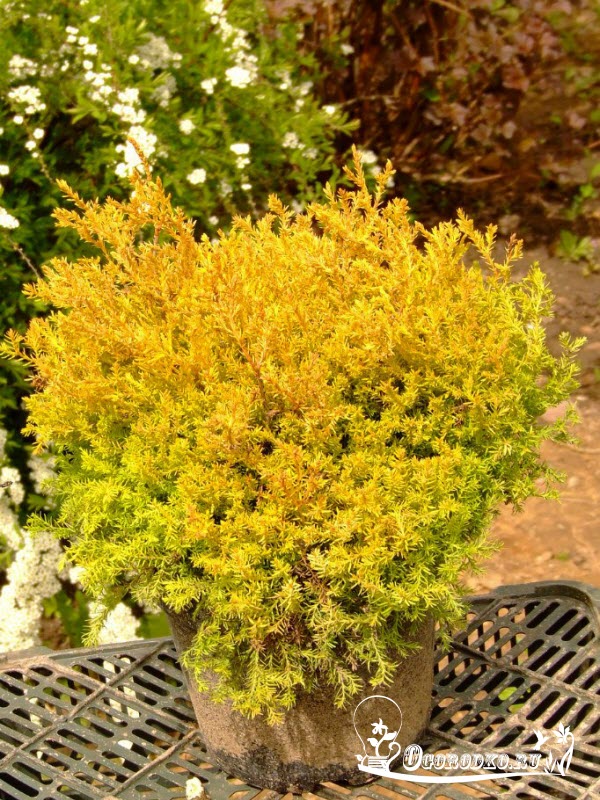 Thuja Zahidna Klot of Gold.
Thuja Zahidna Klot of Gold. 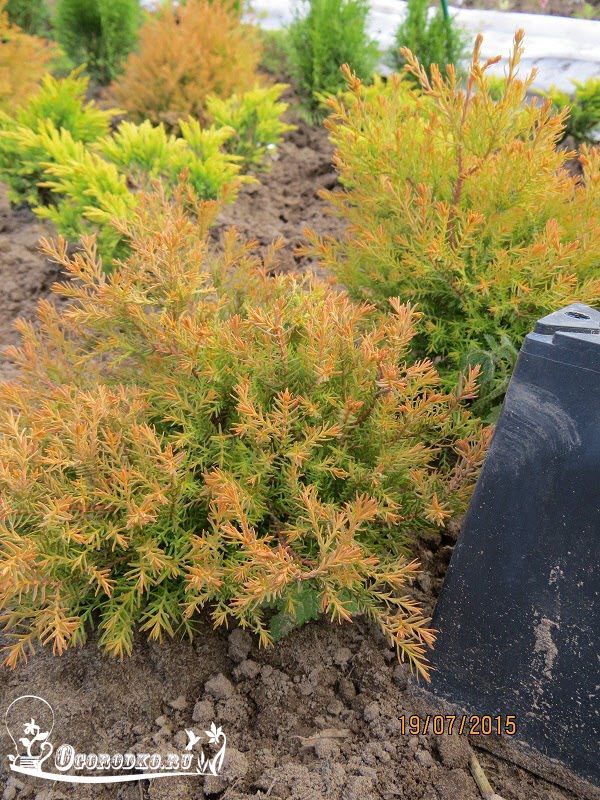 Thuja Zahidna Cloth of Gold.
Thuja Zahidna Cloth of Gold.
Carry out the next haircut, shortening 1/3 of the part of the pagons, troch more. Frost-resistant variety Clot of Gold was supposed to lie for the winter in the first rocks, so that the ops did not settle down, the garrison was left behind.
Ephedra can be seen as small groupings in landscape combinations, or as small specimens for decorating the dacha. Dosvіdchenі gardeners rozmіshchuet roslini in plantations from leafy, coniferous species trees, stone gardens.
Globoza
Thuja Globoza Compacta (Thuja occidientalis Globosa Compacta) is a low-growing cultivar, the roslin has grown - no more than a meter. An ideal dwarf sack with evergreen needles can fit into a little tuft in the country, which does not take up a lot of space, but even more embellishes the underwire.
The needles are luscat, greenish-yellow, dense. Globoza Kompakta is frost-resistant and vibrating, which is an absolute plus when choosing conifers. Cultivated on calmly watery land and dry, soft loam. Chuyna on mineral support organic fertilizers becomes more strained and richer in color.
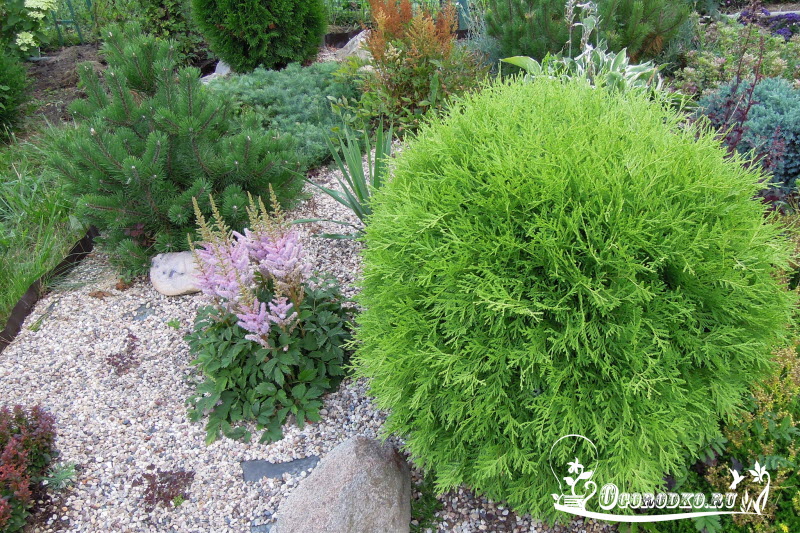 Thuja zahidna Globoza Compacta - on the photo
Thuja zahidna Globoza Compacta - on the photo
Growth is povіlno (4 cm), the crown is rich-stemmed and thick. If you don't know what to plant in rock gardens on a stone terrace, try hanging Globoz Compact. You will certainly delight in a beautiful kultsi, so as to fit into the composition, or grow alone, embellishing the cottage.
Woodward
Thuja Woodwardi (Thuja occidientalis Woodwardi) - bush, with a thin crown (1.5-2.0 m). The width of mature representatives is 1.8-2.0 m.
At ten rokiv, thuja reaches a height of 0.4 m. medium smoothie In the Urals and in Siberia, it is necessary to provide additional protection to young roslins;
At the plantings, you look carefully, a lot of gardeners will plant on the lawn. Roslini spread on the birthplaces of the lands and obov'yazkovo annually, so that the bag did not darken and saved the density.
 thuja zahidna Woodward.
thuja zahidna Woodward.  Thuja zahidna Woodwardi, molded into 5 stems, 15 years - on the photo
Thuja zahidna Woodwardi, molded into 5 stems, 15 years - on the photo
Recommendations for landscape design, stone gardens, solitary plantings. I look without fail in the plantations from the chagars and from the various contagions. Garden paths can also be embellished with this variety of thuja through compactness.
Stovpchik
Thuja Stolwik (Thuja occidentalis Stolwik) looks like a yalinka, as the lower tiers are dense and wide, to the top they are more discharged in a narrow shape. The infestation is green, the new pagons grow yellow and white. Zimostіyka, it is possible to propagate livestock.
Necessary relatives and waters of the territory, the place of roztashuvannya - sleepy. When growing in muddy places, tuї become plump and less decorative. When buying, next to protect, the Stolvik is not too dry, it is recommended to water it well in the sinter and carry out an additional cleaning, so that it will disappear.
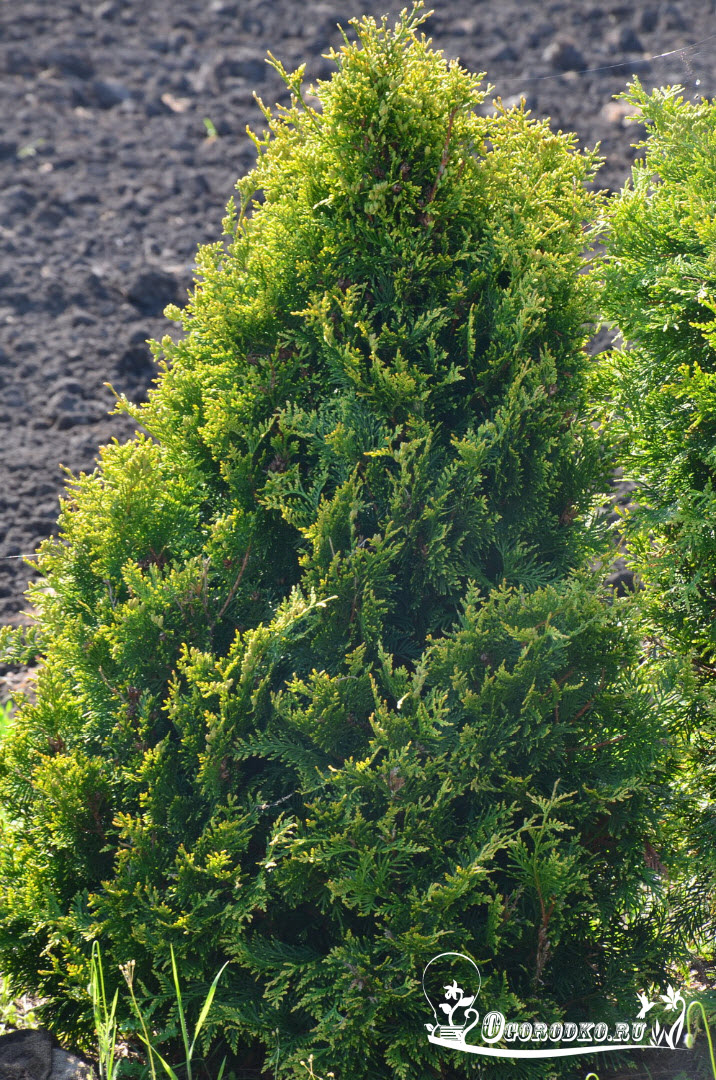 Thuja Zahidna Stolvik.
Thuja Zahidna Stolvik. 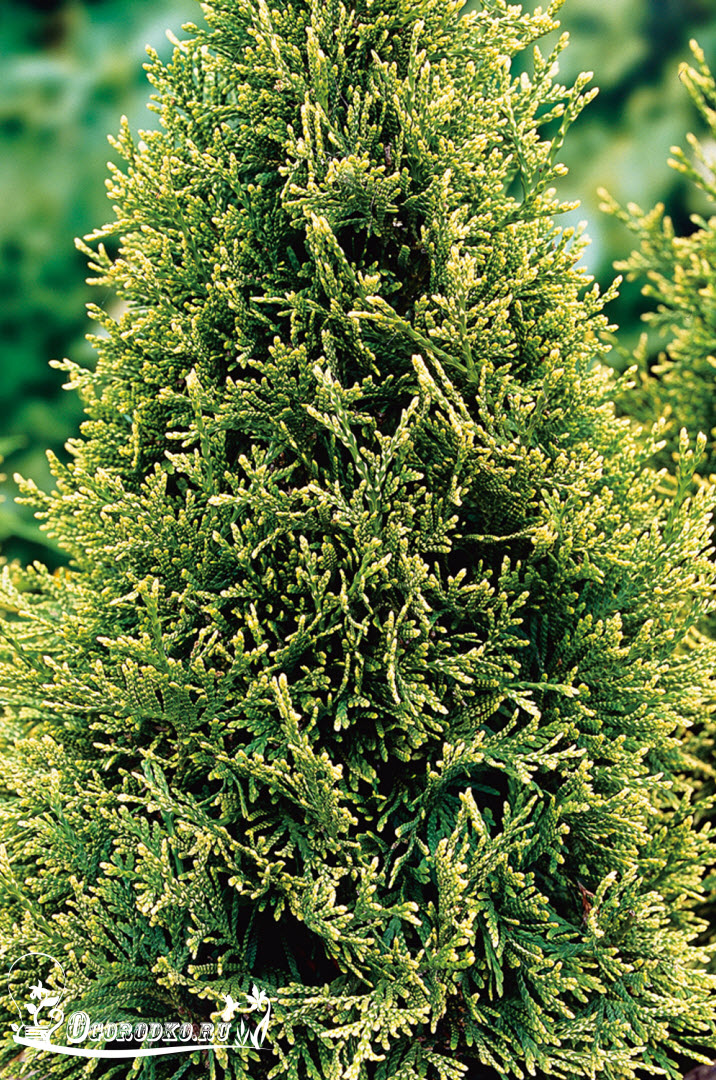 Thuja zahidna stolwijk.
Thuja zahidna stolwijk.
It is easy to get a haircut, the curtains shorten the fringes, so that they give a great cut to the tuy. Planting at mixed borders, rabatkas, vicoristing at the landscape landscaping of trees and gardens, and planting alone.
Danika
Thuja Danika (Thuja occidentalis Danica) - bush, short swamp twigs, growth is strengthened. The dwarf variety grows well (50 mm). The shape of the bag is trimmed practically and ideally from the early century.
 Thuja Zahidna Danica.
Thuja Zahidna Danica. 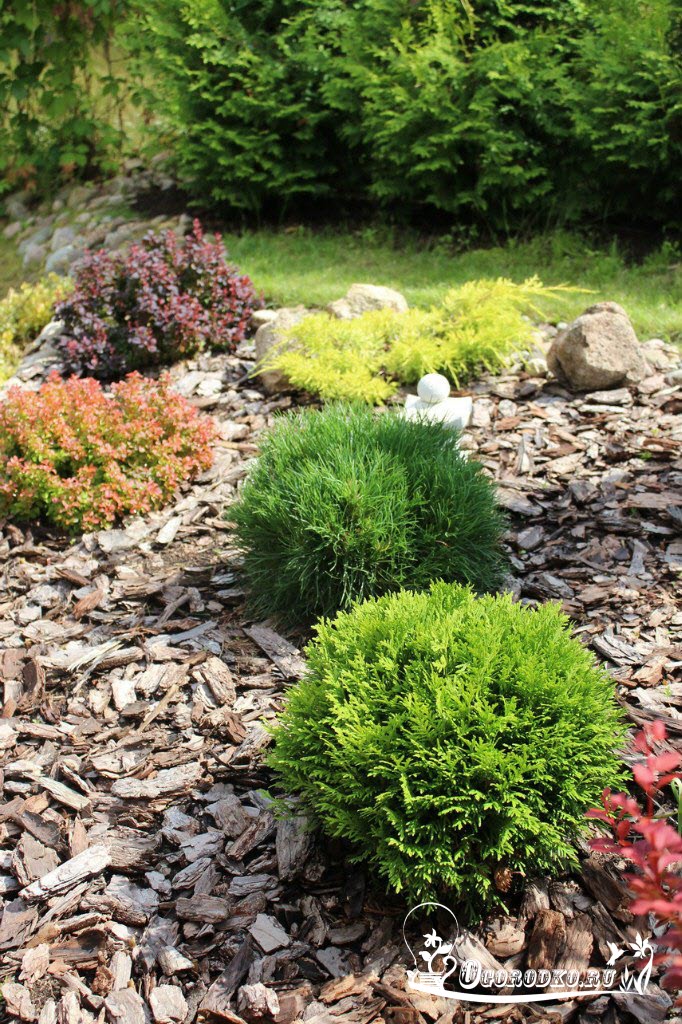 Thuja Zahidna Danika, in the foreground - in the photo
Thuja Zahidna Danika, in the foreground - in the photo
Thuya Danika is frost-resistant and finishes the tіnyovitrivala, multiplies by livestock. Zavdyaki compact roses, low-growing sack of winter is covered with snow and does not fade away with sleepy light.
 thuja Danica in composition with trojans.
thuja Danica in composition with trojans.
Vikoristovuyut for cladding rock gardens, garden paths, borders and others. Thuja is dry, or better to take it out on the loamy loams. When cultivating in the shade, wearing beautiful bushes, outline, become fluffy, shine less.
Golden Globe
Thuja Golden Globe (Thuja occidentalis Golden Globe) - undersized golden dwarf variety (up to 100 cm). Golden-zhovte zabarvlennya greater world є on the corners of the woods, and as if you open the bush with your hand, in the middle you can shake the yaskrava green needles. It grows at a faster pace (80-100 mm), cutting is rarely needed. Hanging for the need to carry out a sanitary trim, removing dry marks.
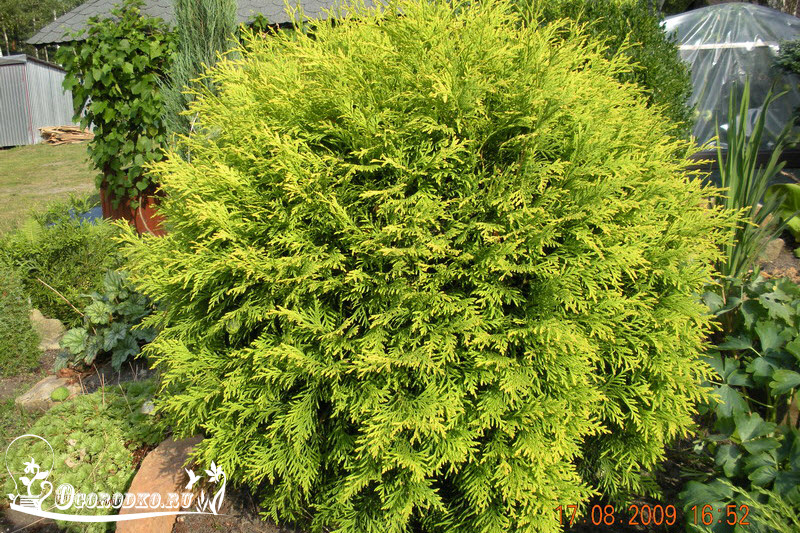 Thuja zahidna golden globe- in the light
Thuja zahidna golden globe- in the light
Bagato gardeners often call the Golden Globe "Zhovta Kulya" or "Zhovta kulasta thuja". Frost-resistant, good growth on light loams, not terrible rainy snowfalls, so like chicks, which will grow brightly, do not let the bush grow to the side.
The dryness of the average, it is recommended to water it and spend it on warm summer days. The golden color is picked up only when cultivated in sleepy beds, in the shade it becomes bright, and the crown becomes thin and fluffy.
 gіlki tuї zahіdnoї Golden Glob.
gіlki tuї zahіdnoї Golden Glob.
Sometimes, with the eye of the wrong sight, the little ones begin to grow in a larger age, they appear to be enlightened, they look no less awesome. In such a mood, slacken a cut of thuja, shortly pagon on 1/3 of a part of the density.
Teddy
Thuja Teddy (Thuja occidentalis Teddy) - a stalky and dwarf variety, it has been recently introduced, so it is new in the bagats. Height climbs at 30-40 div.
 Thuja zahіdna Teddy.
Thuja zahіdna Teddy. 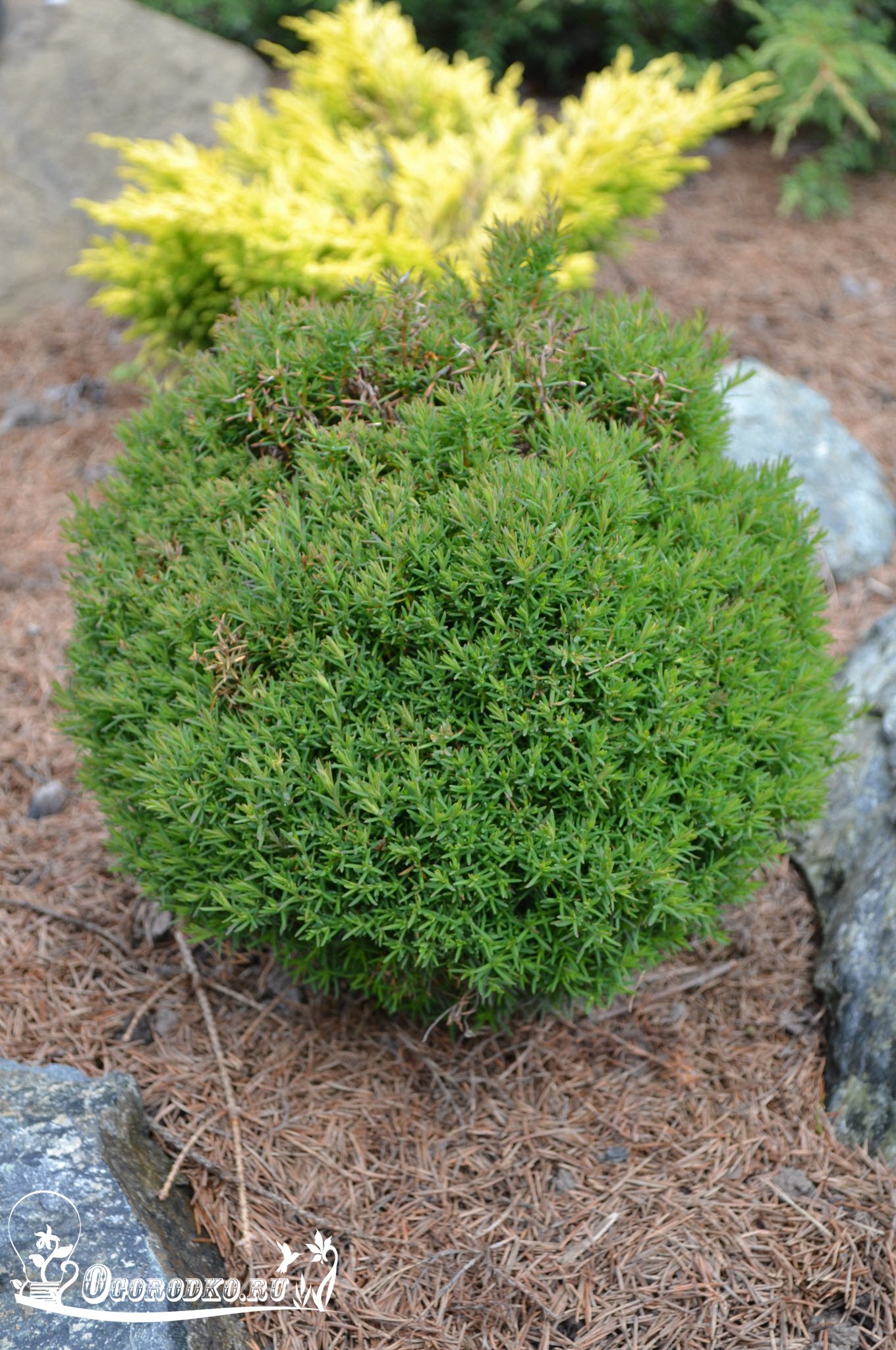 Thuja Zahidna Teddy.
Thuja Zahidna Teddy.
For the tuyi, thickly ruffled thin stilettos are characteristic, as in a young woman, frizzy hilts can be seen. The needles of young individuals have a head, with which we are told not to sting. The color of Teddy is green, autumn - in bronze.
 Thuja "Teddi" in the center - on the photo
Thuja "Teddi" in the center - on the photo  Zahidna thuja"Teddi" - on the photo
Zahidna thuja"Teddi" - on the photo
Planting thujas to be carried out on drained native lands with a fluffy structure, so that the growths react sharply to the narrowed soils. The root system is close to the surface of the soil, galvanized. A winter-hardy representative can be sheared if necessary. Looking carefully in plantings on the lawn, rocky gardens, when plowing paths near the garden.
Hello, the topic of today's article is "Thuja you see and sorts from the photo." The thuja is carried up to cypress bushes, it is easy to form a mold, it can be richly seen and can be victorious for the creation of living partitions and fences. In Russia, love chagarnik through those who win evergreens and help turbot collection.
Thuja see ta sorti z photo
At the middle smoothie of the country, and at the pivnoch, it is bazhano to vikoristovuvat winter varieties bushes of thuja. The stinks do not deprive themselves of respect and do well to pay off. Let's take a look, as if you can see Tuї and sorts, and it is applicable for short accuracy photo of trees.
The tree grows up to 5 meters of the crown, the volume of the crown is 1.5 meters. The color of the needles is more important than green, as it is cold for the winter, the color of the heads can become a brown color. I don’t have a real meaning, because before spring the tree will turn green again.
For a short tree, the tree grows by 35 centimeters of the crown and by 50% of the height of the crown. Roslina can be cut, it’s miraculous to endure the procedure. The tree is not colder to pay, that one does not need to be twisted.
To the appearance of the soil, the chagarnik is not viable, it can do without additional supplements. The growth of Chagarnik is normal, like in the sun, and in a light shade. Bazhano visajuvati grew at quiet places, when there was no strong wind.
The tree can bloom, traplyatsya canopy. After the bloom, you can see small buds of a brown color. Today, autumn is ripening again. For this type of Tui, there are no sharp differences in temperatures in those regions, de buva dovga vіdliga.
The system of life of a tree takes into account the coming spring and the process of ruha juice can begin, and as a result, young trees will freeze if frost sets in.
If you want the tree to grow succulent and green, plant it in a fertile soil and constantly improve the optimal moisture content. In other times, the tuy is richly fruitful, the pagons become sparse and not as fluffy as they could be.
Suitable type of soil for wood: peat, sand and 2 parts of turf and leaf soil. For mature growth, 500 g of nitroamofoska are added to the skin fossa.
In regions where the water content of the earth is increased, and part of the fall before planting of the same kind, better drainage. Ring out to put 20 centimeters into the hole.
If you buy roselin in bowls, then before landing in open the earth pour water well on him, so that the roots become like an earthen breast. The root neck at the hour of planting the roslin is guilty of being overgrown above the ground, otherwise it’s a risk that the tree will die.
After planting a tree, follow the yoga watering. Irrigate a bunch of yogo only once a day, vicorist water on one tree. After that, as the month passed after the root, the amount of water increased by 2 times.
Periodically, the ground under the tree needs to be mulched or fluffed. Practise carefully so as not to harm the root system. Sometimes for mulching, there is cod and peat, the stench is laid 7 centimeters near the depth, no more.
Yakshcho є dry pagons, їх baghano tidy up the hanging doti, how the ruh juice will bud. The cultivation of young trees is transferred to shelter for the winter. Tse help save the lower needles winter frost and hinged windows on the sun. Ring out for whom the spruce branches are being made.
The tree is actively victorious for the creation of living creatures. If you want to touch the wall, then hang it through the skin 50 centimeters. Shave pagons in birch and autumn, allowing the crown to be more quickly formed that way.
If you cut the tops of the trees at the same time, then the stench will grow evenly and stop stretching uphill. The diligent glance that one’s own circumcision brought to the point where you take away the full live parkan.

The tree can grow up to 7 meters of curls; Roslin is not afraid of frost, it does not require a special warehouse. Krone growth schіlna, normal type. On a river tree, you can add up to 20 centimeters of curl.
You can trim and shape the bazhana height of the tree yourself. A tree of this kind vikoristovuєtsya for the creation of partitions and fences. Yakshcho Columna is alone in growth, the Crimean cypress is over there. As soon as you think about the idea of landscape design, the tree will miraculously fit into the plot.
A tree can grow in the earth, be it of any type, it does not need additional support. At the same moment, the thuja develops more quickly, as if growing in the minds of the native soil and raising the moisture of the earth.
It is not good for a tree to endure dry land, it is necessary to take care of it respectfully for the amount of watering. The most beautiful tree will develop, like planting it in the city, de no more than a rich sun. You can cut a tree by giving it a necessary form, thuja calmly endure this fact and grow in that directly, which you need.
If you plant young growth, then it is necessary to twist it for the winter. Tse to fight in order to escape the opіkіv that poshkodzhennya young pagonіv cold. The tree can be victorious for growing in groups or single compositions.

The thuja grows up to 5 meters long, commanding special respect for itself. The varto tree grows less near the kindred earth, take good care of watering. The growth of the thuja variety is weak, on the river it does not give a lot of centimeters.
The color of the needles does not change in the winter, so badly embellishes the house, if everyone grows up to sleep. A weak fence is alive from such trees. Under the hour, the growth of the thuja does not flicker with other top trees, which is what it looks like to the livestock.
Qiu roslina can be vikoristovuvaty for vyroshchuvannya in dzhkakh chi single compositions. A place for such a tuy is better than choosing a sleepy one, but a tree can grow calmly and on a mіstsevosti, de buvaє tіn.
Cold Smaragd endure normally. To plant trees on the plots, let there be no wind, so that especially cold days can be frostbite. Young growth for the winter is covered with sackcloth and other material. How can you not kill it, it’s obvious that it’s easy for young people to perish under the exchanges of the spring sun, or to freeze the winter.
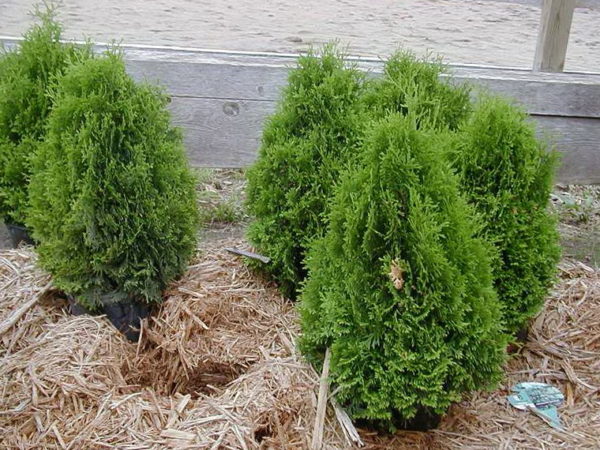
The tree grows up to 3.5 meters with a curl, forming a column. The width of the trees near the area is one meter, the bushes grow densely, the crown is open. The tree does not change the color under temperature changes. The thuja vzimku looks green and juicy, does not freeze in severe frosts. Roslini can be shaped, it’s normal to endure pagon haircuts.
Thuja does not have special respect and can grow on the earth, be it of any type. To the standard age, it takes 20 years to grow. Zagalom on the river tree add 12 centimeters. If you are creating livestock from a tree type, then it is necessary to cut the pagons approximately once every 2 years.
Holstrup is good for those who create a garden for generations, but don’t want to take wine for a rich hour. The tree grows well in a puffy earth with good signs of birth.
Watering is consumed by death, do not like dry thuja. For the first 3 years of life, the growth of yogo for the winter is covered with insulating material, the earth was covered with root varto with spruce branches, so that the pollen mice did not lick. Roslin miraculously victorious for single compositions, rockeries or created for living creatures.
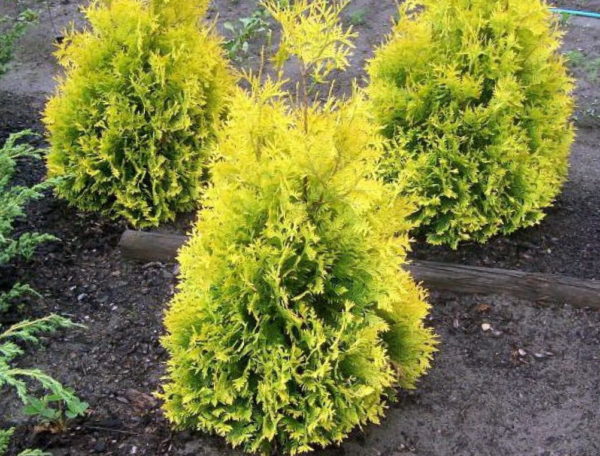
Thuja of this kind can be of two types: a small tree or a chagarnik. Grow up, sound at a height of 3 meters. Needles may be light brown color and growth at different sides. Young growth may have a golden color, and with age the tree may become bronze.
The cultivar grows even more naturally. For 10 years, the tree will be less than 2 meters high. Plant a varto tree there, de richly light. The land for planting can be good, but rather take the land with good family and follow the irrigation regime.
You can cut it without a fight, you’ll die, the tree is badly adapted to a haircut. Call the vzimka do not freeze. If the irrigation system is destroyed for a long time, then the thuja will be crooked by the numerical strength and waste its decorative look.
How to plant a roslina in a pivtin, it will end up with it, as it is naturally planted with needles, and there will be a green color. For planting tsich roslin choose close the place, where the wind is not strong. Cut this kind of varto behind the bajans, like shaping the crown.
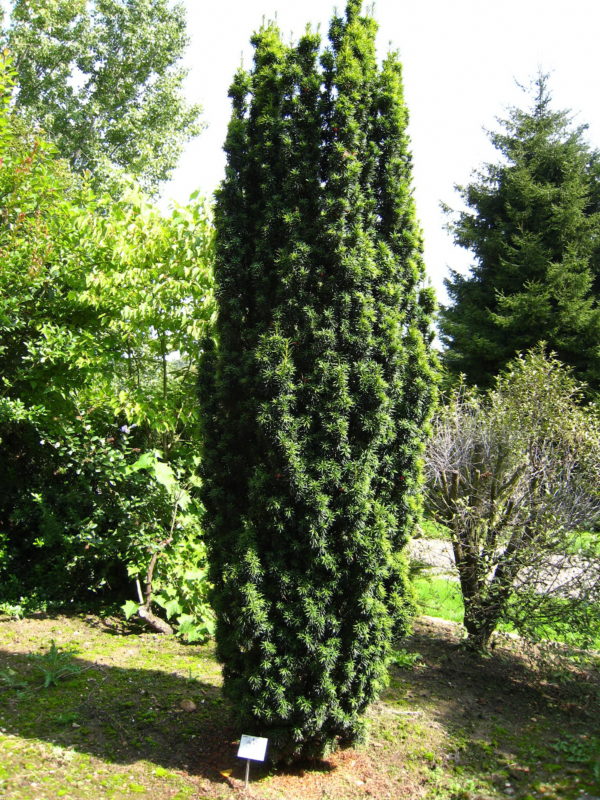
The whole tree in its shape is similar to the Crimean cypress. Curls curl up to 6 meters. Vtechі vtyagyuyutsya dosit shvidko, for r_k can grow up to 30 centimeters of a new obyagu.
The color of the needles is green, there may be an aroma characteristic of tuї and soft on dotik. The tree can endure the winter calmly in the middle climate of the country. If you see the cones in front of you, they are practically not visible on the tree.
That varto pіdrіzati i moldovat їy I will need a crown. Even if you don’t work, you can end up with it, so that the tree grows in different sides and transforms into a majestic and neohayny bush.
Good growth of thuja in loamy native land. It is also necessary to follow the water regime. Rich water does not go to the bark of growth. Like in your region, fall down or increase the moisture content of the soil, warn about a good drainage system.
For the winter, the young grow in the cold with burlap and do not know the doti, the temperature does not stabilize. Periodically, it is necessary to mulch the soil with dried grass. Tse dopomozhite to improve the yakіst of the earth and the signs of the growth of the tree. Thuja of this kind vikoristovuetsya mainly in order to create livestock. Looking at such a parkan beautifully, it does not take up a lot of space and fits into landscape design.

That kind of mind can be called a tree, її rozmir rarely syagaє 2 meters. Thuja tsієї roslini can take the form of heads or lusochok. Under the infusion of low temperature, it becomes practically a medium breeze.
On the rіk thuja give a small increase and vimagaє respect. Dobre її plant on the native soil with external drainage. An important factor is the presence of the meadow and the optimal water content. Too much drive not to love.
Plant the roslin better at the bright city. As the tree grows in pivtin, then the color of the crown is not uncommonly strongly zipsuetsya. Roslini need regular circumcision, ring out the tretina of the eye.
Roslin has grown up not to be afraid of the cold, and the young growth in the first river of life needs to be twisted for the winter. Thuja vikoristovuetsya for the creation of small compositions, decorative living fences and for a single planting.

In good minds, bushes can grow up to 3 meters or more. The needles of the thuja are green on the back, and until the winter it fills up with a honey-colored flower. Tree varto visadjuvati on open space, de rich sun. At the same hour, unify the city, where the strong wind is.
Thuja will grow well in the native land with optimal moisture.
A cut of the growth is less likely to be shy at the time of consumption, the thuja kindly shows its shape. Vzimku krone mozhe lamatisya under the snow cover.
In order to avoid trapilos, it is necessary to sling the frogs at once, but marvel at the fact that the bobbins are not tightly tightened. Otherwise, you can mess up the bastards. Thuja is not afraid of frost, as it is often harvested near the middle smoothness of the country.
Roslina can be grown in bowls, vikoristovuvatime shaping the alleys of the creation of okremikh landscape decorations.
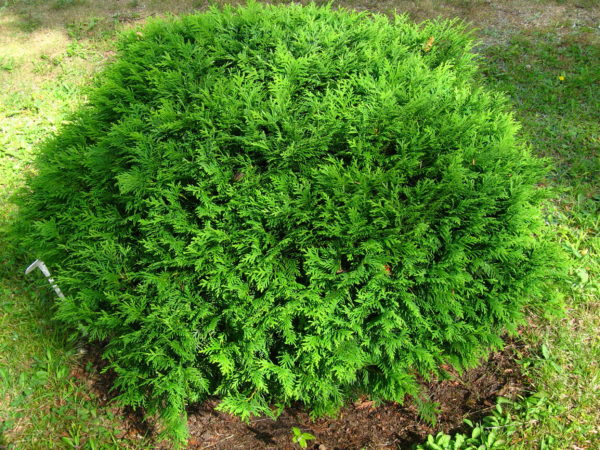
The tsey variety of tuї is vvazhaetsya undersized. Behind its shape, the bush is guessing a sack at a radius of 60 centimeters. In the spring, the needles may sap the greenery, and the collection becomes a middling color. Chim is the elder bush, and the needles are growing wider.
It is enough to mow the bushes to the height, for the rivers they will add the whole sprat of centimeters. Visajuvati grows more quickly into a germinating soil and dotrimuvatisya watering regime. Bazhano, the water level was on the middle level.
The cold is not afraid of any kind of Tui. Juveniles can hibernate under snow for a long time. Vletku speku varto zvernuti respect for watering the growing. With a good level of watering, the chagar will grow up and in the future the juices of greenery will grow.
For this purpose, the roslin developed better than the vicorist mulch for the soil. Tse rob with peat or cut grass. Fall the earth near the root system and cover the varto chagarnik with spruce branches, so that the thuja ceases to be hospitable for bears.
Roslin does not need to trim and give shape. Thuja of the same variety vikoristovuetsya for rozpodіlu garden on the functional zone, kvіtnikіv creation. The chagar-garden looks wickedly near the bushes and when planted in small groups.

Chagarnik is supposed to be a sack with a diameter of up to one meter. The growth of the thuja is sufficient to grow, for the growth of the crown to become 5 centimeters. It is not necessary to trim and shape the crown for the chagarnik.
The young growth will become more mature in a full-grown bush only after 15 years. Reproduction of chagarnik is mainly used for live bait, but it is possible to bathe and ready growing, growing in a rose.
You can grow this variety on sun and in shade. Roslin does not react strongly to frost and does not freeze. Danika is actively vikoristovuєtsya for the creation of rock gardens, fence for flower beds, livestock and zoning space.
I will turn in the darkness of the thuja to change into a kudlat bush, which it will be impossible to give shape to. As a way to add minimal respect to the growth, it will miraculously fit into the landscape design of your farm.
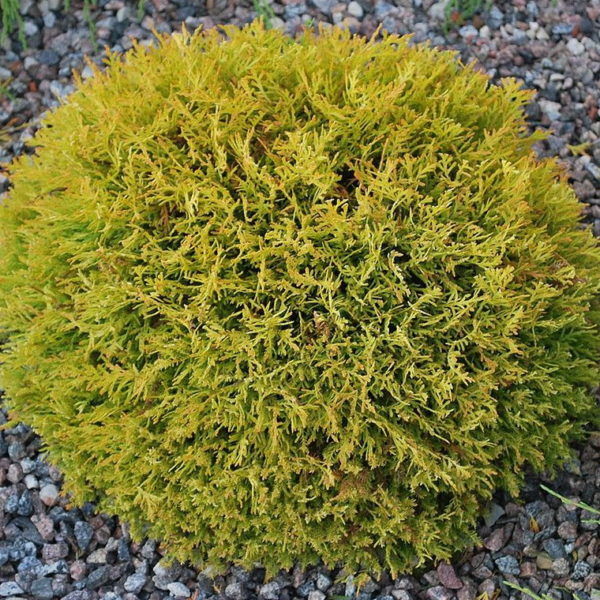
Another variety of low-growing thuja, which looks like a sack. The height and diameter of the growth is approximately the same and becomes 1 meter. Chagarnik grows wonderfully, is not afraid of frost and can winter without shelter.
The needles may be greenish-yellow, which becomes more pronounced from the present winter. Increase obsyagu tuї є dosit povіlnym, for river won can grow up to a maximum of 10 centimeters. In order for the roslin to be nabula with a written shape and a diameter of 2 meters, it is possible to go through 20 years.
For the cultivation of this type of tuy, loamy soil is needed. Roslina will require regular watering and supplementing with mineral and organic rechovins. It is necessary to mulch the earth in order to make it sour and improve the pace of growth.
Mulching the earth to fight with grass or peat, in autumn the earth can be covered with spruce branches. The main shkіdniki tuyi are pole bears. The stench to roam nests near the root system and roar it. If the soil is covered with spruce branches, it is not so easy to naughty grow.
Thuya Golden Globe does not like dry hot air. In summertime, it is necessary to water the chagar garden more often and sprinkle it with water from a garden hose. Respectfully watch out for the growing stretch of fate. As if with a raptom, the thuja becomes dull, and the needles grow to the sides, which means that the time has come for a haircut for the roslin.
After that, as you cut a part of the pagons, the chagar plant will develop better, and the needles will come number of colors. Vykoroslinu can be grown in rock gardens, rockeries, for making single plantings with vikorosliny kaminchikiv and pisk.
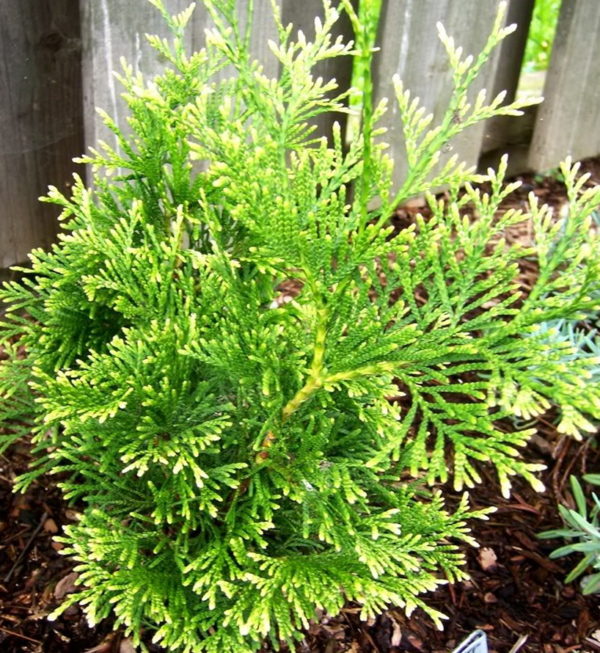
This species of tuї nagaduє chagarnik and grows up to 1.5 meters. For a complete development of the bush, 10 years are needed. Chagarnika needles maє green colors. It is normal for Roslina to endure frost and change color in the cold.
Visajuvati grows better on native land and follow the water regime. Reproduction is carried out with live bait, or you can buy ready-made growers in bowls. Viroshchuvannya tuї z zhivtsіv loan for more than an hour, lower at the drop, if you come ready roses.
That kind of visadzhuyut on a sleepy dilyantsi. In the darkness, the chagar bush becomes fluffy from the needles of an unintelligent eye. Roslin does not tolerate overdry weather, all summer it is necessary to regularly sprinkle with water.
For the shortest growth of roslin soil, it is necessary to mulch with peat or grass. In autumn, the soil near the root system is covered with spruce branches for the protection of wild rodents. Young growth is not afraid of frost, it does not need to be twisted in the cold.
It is necessary to shape the crown, if you want to give it the shape of a cicada. Trim the pagons to finish off the shvidko. Chagarniki of this kind vikoristovatsya for the creation of a living parkan, zoning the expanse of that creation of simple landscape embellishments.
You deserved the article “Thuja, see that variety from the photo”!

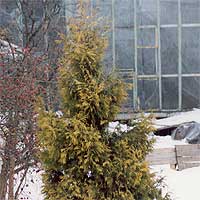 Thuja occidentalis "Aurea"
Thuja occidentalis "Aurea"  Thuja occidentalis "Lutea"
Thuja occidentalis "Lutea" 

